Early in the 20th century, Los Angeles continued to grow, and by the early 1920s, it had surpassed San Francisco in size. The city’s population had risen to over one million in the late 1920s. Petroleum became an important industry, with extractions planned from large Huntington Beach, Long Beach, and Santa Fe Springs reserves. The manufacturing industry boomed, and the city became the aviation capital of the US and occupied the ninth position in the nation’s industrial cities. The eight major Hollywood studios produce 90% of all major films and control movie theatres and film distribution rights. A large banking sector developed in Los Angeles port, which became the second busiest Deepwater port. One-third of Los Angeles’ homes were privately owned by homeowners, unlike other major US cities where housing was largely rented, as the emerging economy fuelled by oil and Hollywood real estate grew.
By 1921, more than 80 per cent of the world’s film industry was located in Los Angeles. During the Great Depression, the city’s economy was insulated from much of the economic loss experienced by the rest of the country. Several famous landmarks and buildings were constructed during the 1920s. The Biltmore Hotel was constructed in 1923. The Hollywood sign was also erected for the first time in 1923. The Hollywood Roosevelt Hotel opened in 1927. The city hall was built in 1928.
#1 Glendale Boulevard, looking north under Sunset Boulevard, 1925
#2 Mulholland Highway and Cahuenga Boulevard, 1926
#3 Macy Street Viaduct, a span of the finished bridge, 1923
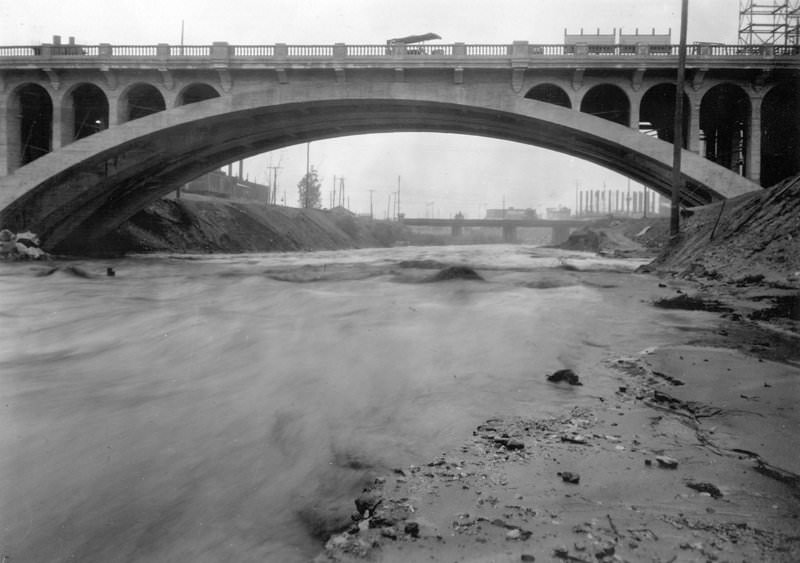
The main span of the completed Macy Street viaduct. This river bridge is part of a group of 12 river bridges notable for their role in the transportation history of Los Angeles and their association with Chief Engineer Merrill Butler, one of the most renowned bridge designers of the period.
#4 Main Street, 1926
#5 Glendale-Hyperion Viaduct, 1926
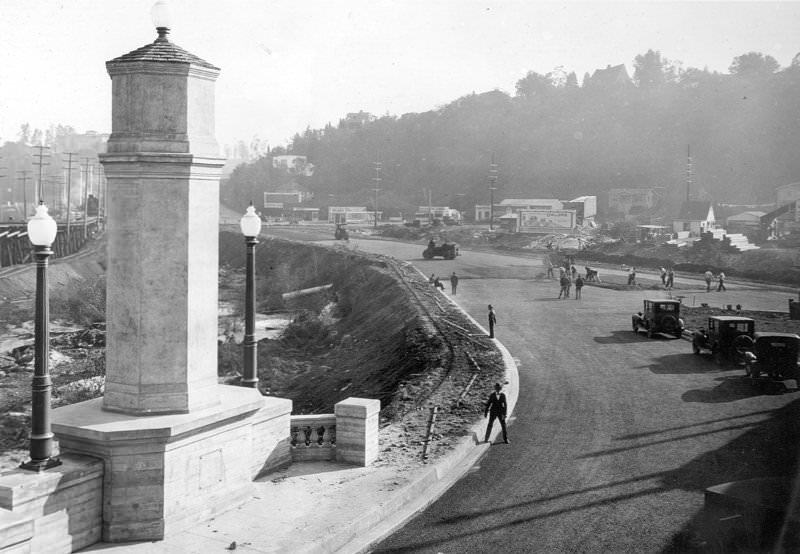
Paving of the road from the south approach Riverside Drive on the Glendale-Hyperion Viaduct. Cars and people were walking on the paved road. Glendale-Hyperion Viaduct and Bridge is 56 feet wide, 1,340 feet long, and has thirteen concrete arches. As a Los Angeles Historic-Cultural Monument since 1976, it was designed by Merrill Butler. He was the city's chief bridge engineer in the 1920s and was responsible for constructing most of the city's historic bridges.
#6 Seventh Street Viaduct, 1923
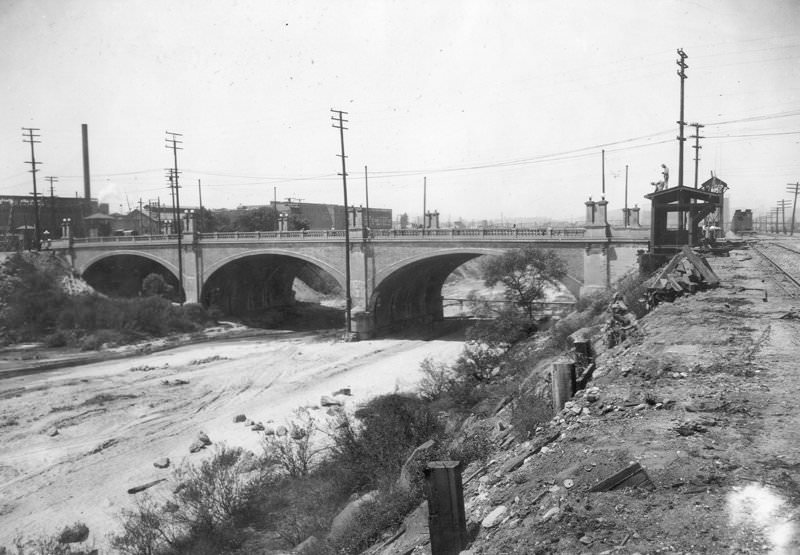
Viaduct over Seventh Street. A total of 12 river bridges were built between 1923 and 1928, most of which are significant because of their role in the transportation history of Los Angeles and their association with Chief Engineer Merrill Butler, a prominent bridge designer of the era. In 2008, it was designated a Los Angeles Historic-Cultural Monument.
#7 Macy Street Viaduct handrail, 1923
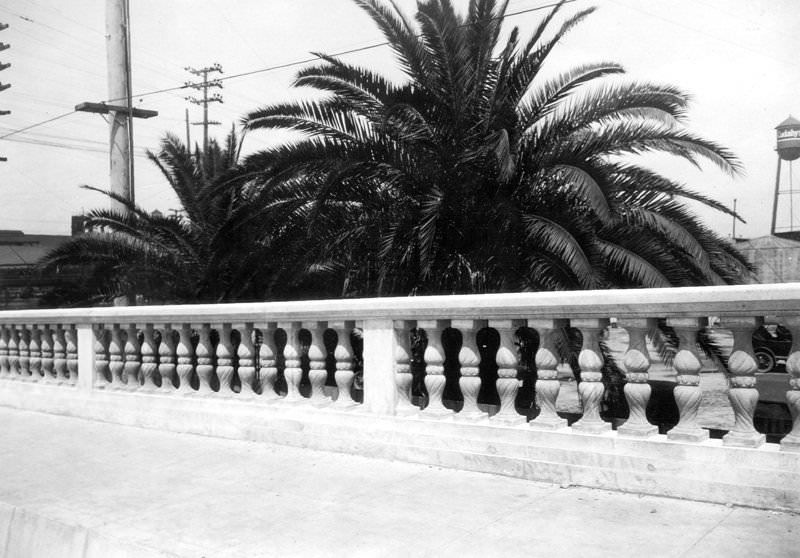
Handrail on the Macy Street Viaduct. In Los Angeles, the Macy Street viaduct (bridge) is part of a group of 12 river bridges associated with Chief Engineer Merrill Butler, a prominent bridge designer of the era, most of which were built between 1923 1928. In 1979, it was designated a Los Angeles Historic-Cultural Monument.
#8 1909 Macy Street Bridge, 1923
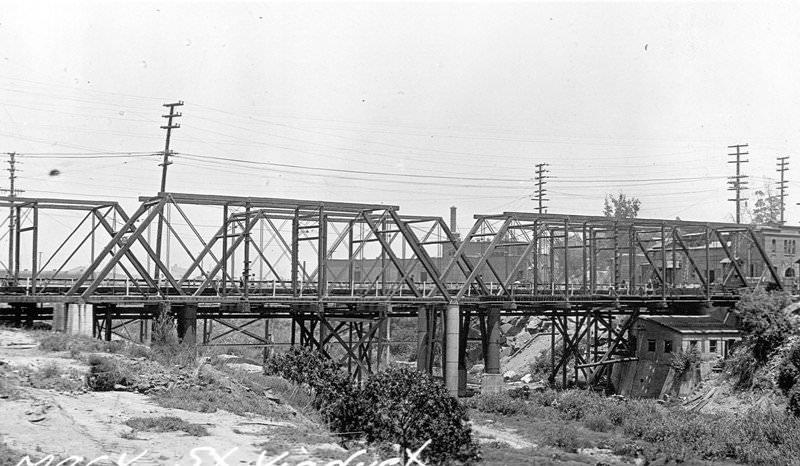
Built in 1909 to replace the first permanent river bridge built in Los Angeles in 1870, it was poor by 1895. It originally carried Old Aliso Road, a segment of El Camino Real later known as Macy Street and now named Cesar Chavez Avenue. In July 1904, the bridge was finally demolished and replaced with the Macy Street viaduct in 1928. In addition to the Macy Street viaduct, 12 river bridges are noteworthy for their role in Los Angeles' transportation history and their association with Chief Engineer Merrill Butler, a major bridge designer of the era, most memorable of which were built between 1923 and 1928.
#9 Wilshire Boulevard, 1925
#10 Universal City Bridge, 1925
#11 Anaheim Street Bridge, looking north from the south end and on the west side, 1925
#12 Glendale Boulevard, 1925
#13 Universal City Bridge for Carl Laemmle’s Universal City Pictures on the former Taylor Ranch in Lankershim Township, 1925.
#14 Nordhoff bridge over the Pacoima Wash, 1925
#15 West Silver Lake Drive, 1925
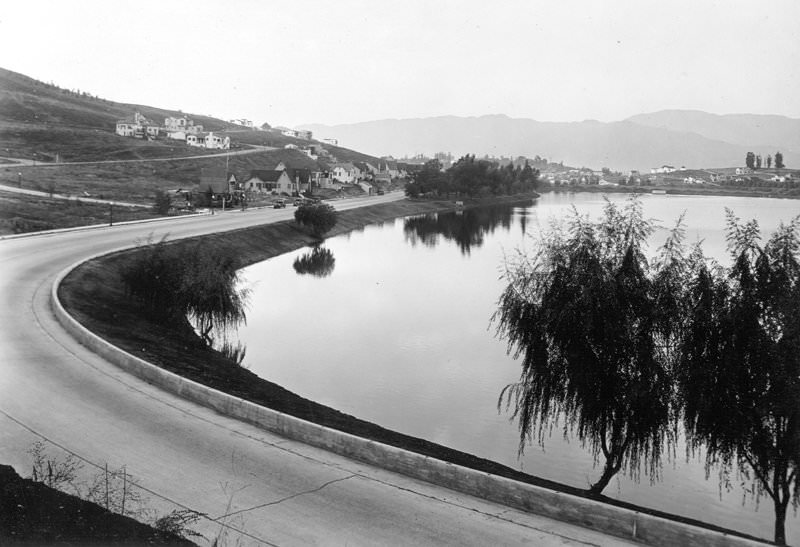
Looking north across Silver Lake from West Silver Lake Drive. In 1925, real estate developers George W. Dickinson and Company built a new housing project along the west shore of Silver Lake and named it West Silver Lake Drive. The "Moreno Highlands Lake Front homes" were completed between 1926 and 1927. The engineers working on the streets, curbs, and sewers called it "Redesdale," a street in the hills northwest of Silver Lake.
#16 West Silver Lake Drive, 1925
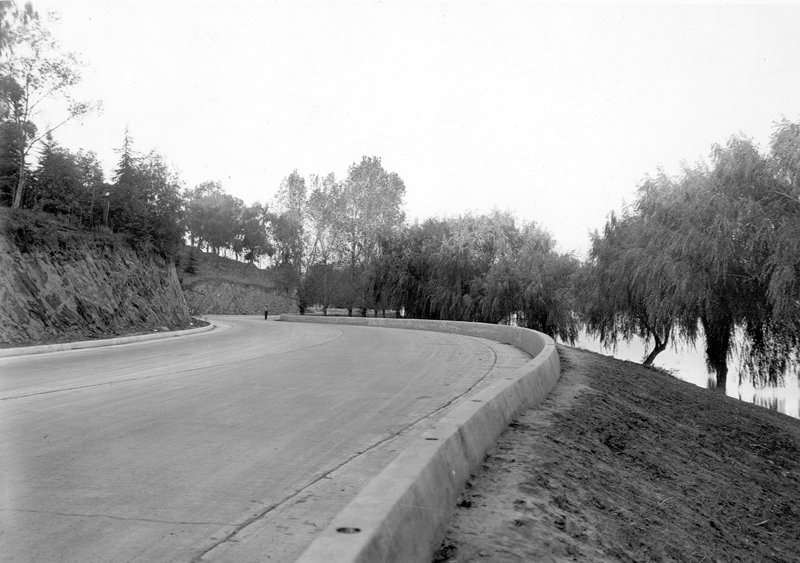
View of West Silverlake Drive from near the Silver Lake Dam. George W. Dickinson and Company developed a new housing project along the west shore of Silver Lake in 1925 that gave rise to West Silver Lake Drive. "Moreno Highlands Lake Front homes" were completed in 1926-1927. Engineers working on streets, curbs, and sewers referred to Redesdale Drive as a street in the hills northwest of Silver Lake.
#17 Looking toward Southwest Museum from Montecito Heights, 1925
#18 Arroyo Seco bank protection, 1926
#19 Echo Park Avenue, 1926
#20 Old East Fourth Street viaduct, 1926
#21 East Fourth Street, 1927
#22 Glendale-Hyperion Viaduct, 1927
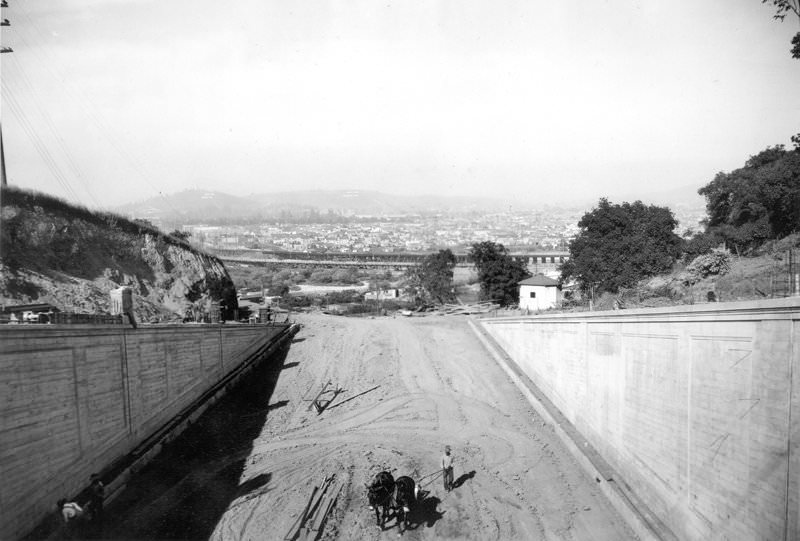
Looking east from the site of the bridge across the Los Angeles River from the Glendale-Hyperion Viaduct crossing at Waverly Drive. The Glendale-Hyperion Viaduct and Bridge is 56 feet wide, 1,340 feet long, and has thirteen concrete arches. It was designed by Merrill Butler, the city's chief bridge engineer during the 1920s, and was responsible for most of its historic bridges.
#23 Pico Street Bridge, 1927
#24 Malibu Road Bridge Number 2, 1921
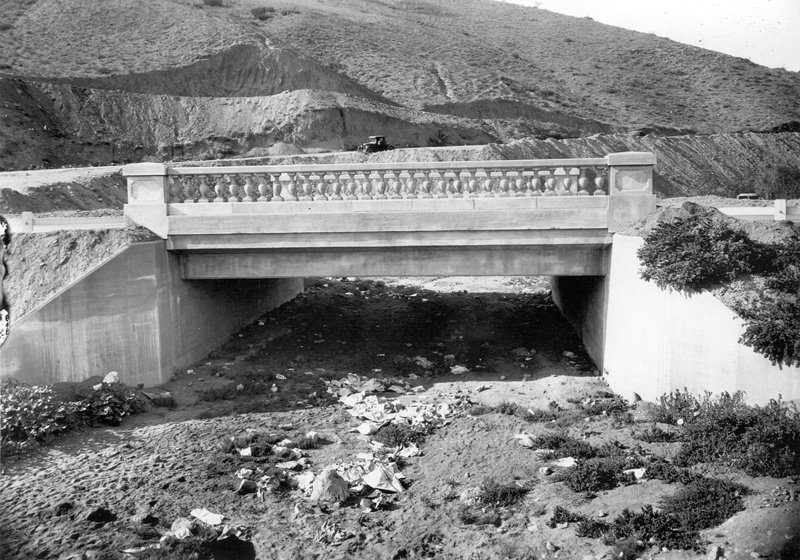
The Malibu Road Bridge Number 2, located in Rancho Malibu, is owned by May K. Rindge. The Southern Pacific Railroad applied to the Interstate Commerce Commission in 1904 for permission to build tracks connecting the Long Wharf in Santa Monica with their northern lines at Santa Barbara. A straight line was proposed through the Malibu ranch. To keep the giant railroad company from coming through Rancho Malibu, the Rindges built a private railroad through Rancho Malibu because there was a loophole in ICC law preventing condemnation of the right-of-way parallel an already existing railroad. Rindge made 15 miles of standard gauge railroad called the Hueneme, Malibu, and Port Los Angeles Railway in 1908 that remained in use until the 1920s, mainly used to ship grains and hides from the ranches via the Malibu Pier. The line ran from Las Flores Canyon to Yerba Buena Canyon in Ventura County, using the flat sand along the coast and crossing canyons with immense trestle bridges.
#25 Malibu Road Bridge Number Two, 1921.
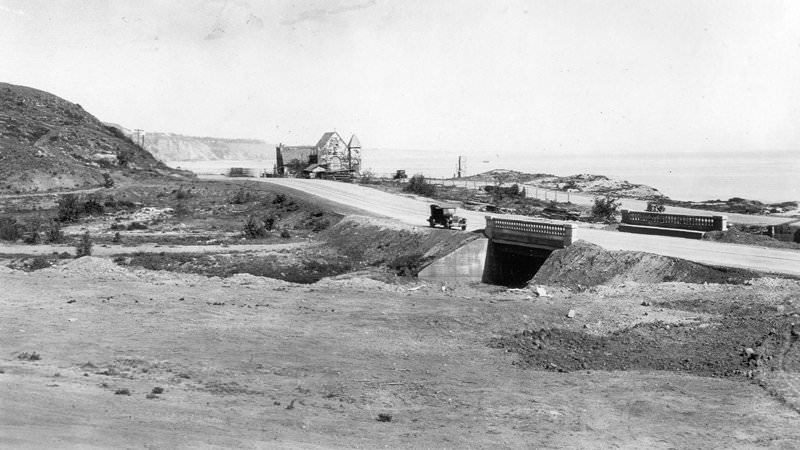
Malibu Road Bridge Number 2, bridge and county road, looking west. Southern Pacific Railroad applied to the Interstate Commerce Commission in 1904 to build tracks linking Long Wharf in Santa Monica with their northern tracks at Santa Barbara. Through the Malibu, the ranch was proposed a straight-line connection. Because of a loophole in the ICC law, the Rindges decided to build a private railroad through Rancho Malibu to keep the larger railroad company at bay. May Rindge built 15 miles of standard gauge track called the Hueneme, Malibu, and Port Los Angeles Railway in 1908, which remained in service until the 1920s, mainly to ship grains and hides from ranch operations via the Malibu Pier. The line ran from Las Flores Canyon to a point near Yerba Buena Canyon in Ventura County, using flat, sandy land along the coast and traversing canyons with enormous trestle bridges.
#26 Malibu Road Bridge Number Two, 1921
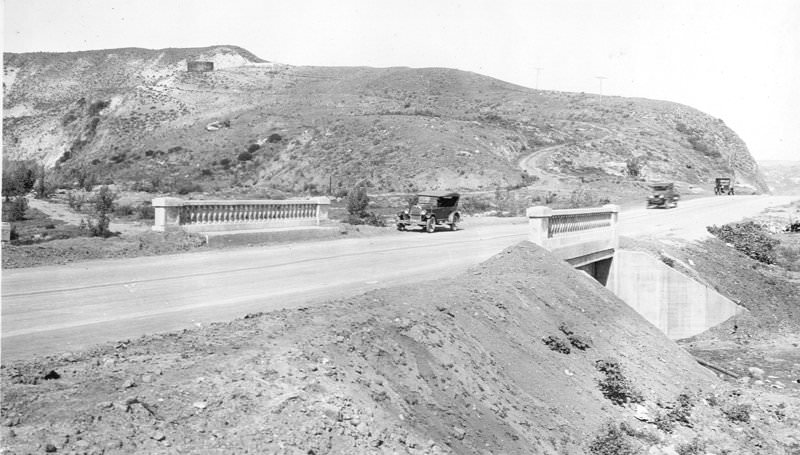
Los Angeles County condemned Rindge's right-of-way and began building a road in 1919. Mrs. Rindge continued to fight in court and resist survey and construction work, but that only delayed the road. On November 3, 1921, the County Road through Malibu Ranch was finally opened to the public despite May Rindge's objections.
Mrs. Rindge lost her case in the United States Supreme Court on June 11, 1923, and a road easement was granted to the State of California through the Malibu Ranch. In some places, the state highway right-of-way followed the County Road. In others, it was constructed parallel to it. By 1925, the Superior Court awarded the State title to the right-of-way through the Malibu Ranch, and the final condemnation was issued two years later. Pacific Coast Highway, originally named Roosevelt Highway and renamed in 1969, opened to the public in June 1929 between Santa Monica and Oxnard, 22 years after the first court action.
#27 Working Jetting Water at Peat Fire, 1923
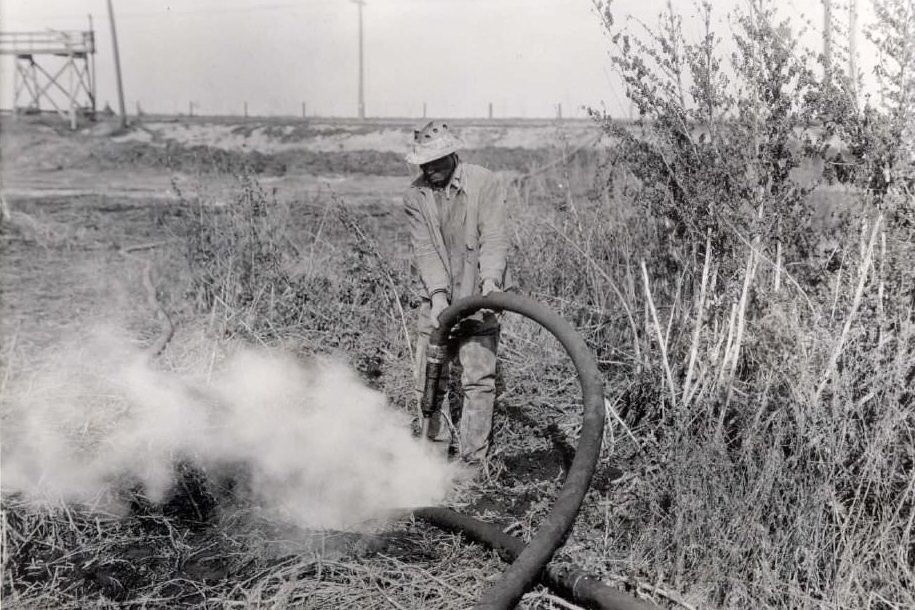
Peat fires began July 1923 from a peat bog under an old river as a relatively small, smoldering fire that initially covered two acres and eventually covered fifteen acres. As a result, fires continued to erupt until four years later when City Engineer Shaw diverted Centinela Creek into an eight-foot-wide by the two-foot deep channel through the peat bogs. A worker jets water at the active fires on the west side of a peat fire above the flood water pond.
#28 Peat Fire, 1923
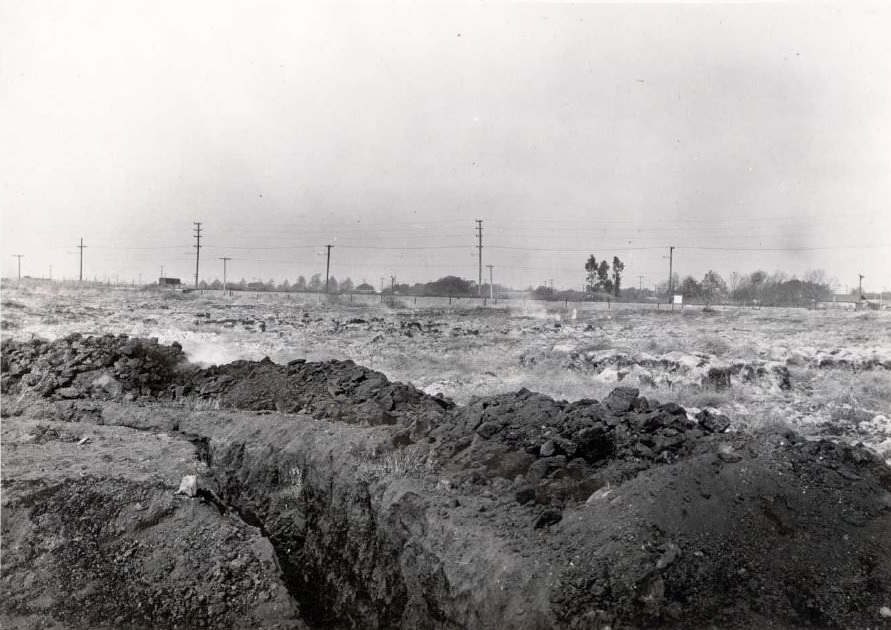
There is a long-burning peat fire in Baldwin Hills, looking south from a point outside the frame about 100 feet east of the corner, at the end of Exposition Boulevard and south of Airline Railway. This fire began in July 1923 from a peat bog under an old river. A relatively small smoldering fire eventually spread to fifteen acres, causing widespread smoke and foul odors throughout the West Adams neighborhood of Los Angeles. The city was unable to put out the fires until City Engineer Shaw, in November 1927, diverted Centinela Creek into an eight-foot-wide by the two-foot-deep channel through the peat bog beds.
#29 Seventh Street Bridge, 1923
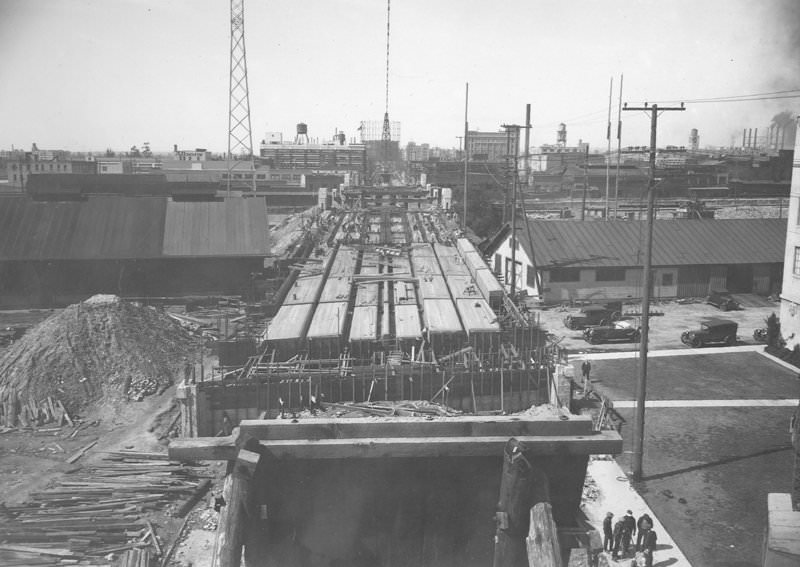
Taking a look west from a tower on the east end of the Seventh Street Bridge. The bridge is part of a group of 12 river bridges significant for their contribution to Los Angeles' transportation history and their association with Chief Engineer Merrill Butler, a bridge designer of the time, built between 1923 and 1928. In 2008, it was designated a Los Angeles Historic-Cultural Monument.
#30 Sewer construction for Verdugo Road and Glassell Avenue Storm Drain, 1923
#31 Peat Fire, 1923
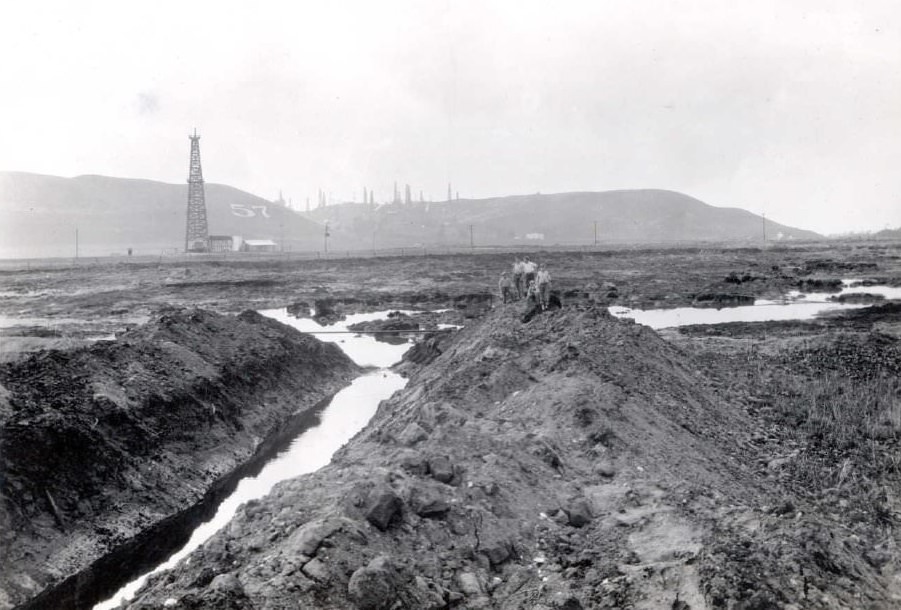
A peat fire that began July 1923 under an old river began as a relatively small smoldering fire that covered two acres and eventually spread to fifteen acres. After numerous fires erupted, City Engineer Shaw diverted Centinela Creek into an eight-foot-wide, two-foot deep channel through the peat bog beds. Photographed south of Airline Railway, near the end of Jefferson Boulevard, looking east up the temporary flood channel, boys walking along with it. In the background, oil wells in Baldwin Hills.
#32 Centinela Creek, 1923
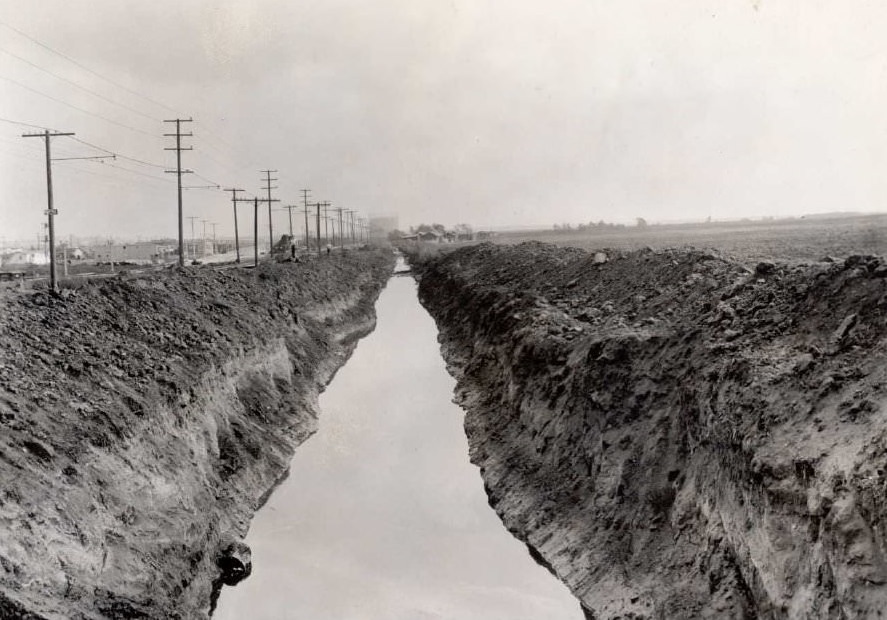
It began as a relatively small smoldering blaze that covered two acres but eventually spread to fifteen acres from a peat bog under an old river in July 1923. In 1928, city officials were unable to put out the ensuing fires until City Engineer Shaw dug a channel through the peat bog beds eight feet wide and two feet deep.
#33 Temporary Bridge Over Peat Fire, 1923
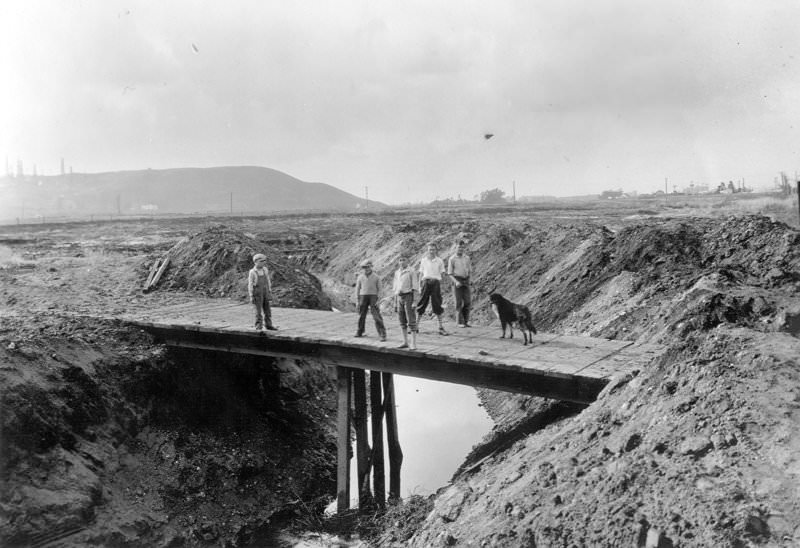
Three boys cross a temporary bridge across the Centinela Creek channel due to a peat fire that began July 1923 from a peat bog under an old river and started as a relatively small smoldering fire that covered two acres and eventually covered fifteen acres. Until City Engineer Shaw diverted Centinela Creek into an eight-foot-wide by the two-foot deep channel through the peat bogs, city officials could not extinguish the many fires.
#34 Seventh Street Bridge, 1923
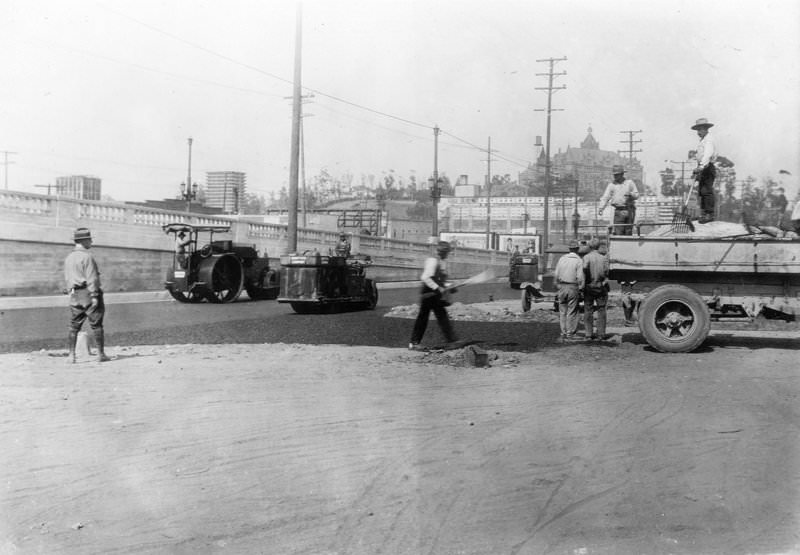
Asphaltic concrete paving around the east end of the Seventh Street Bridge, looking northeast. One of 12 river bridges associated with Chief Engineer Merrill Butler, a prominent bridge designer of the time, most of which were built between 1923 and 1928, this bridge plays an essential role in the transport history of Los Angeles.
#35 North Outfall Sewer Lakeside Country Club, 1923
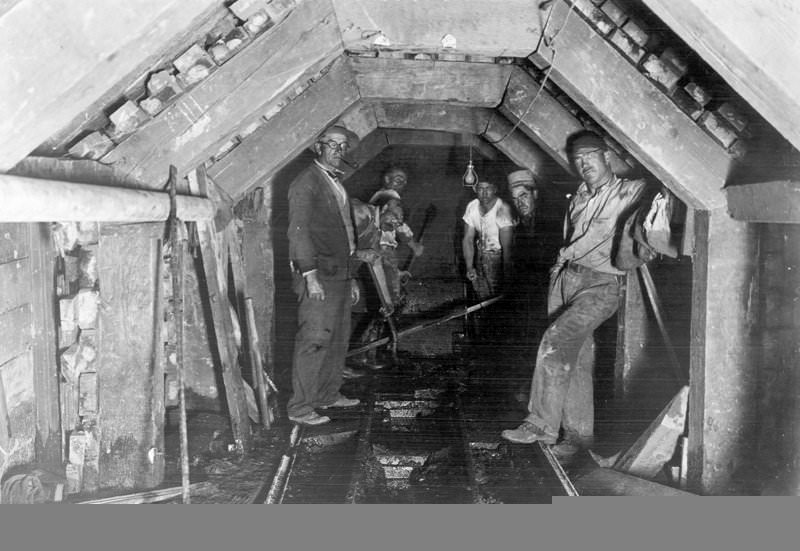
Additional construction on the North Outfall Sewer. Sets and heading for 3'6" precast pipe drain at Lakeside Country Club, adjacent to Toluca Lake. With 55 miles, the North Outfall sewer is the most extended in the United States. It originates in Canoga Park, near the Los Angeles River, and resembles a snake that grows as it becomes more prominent, winding its way along with the Los Angeles After running alongside the river to downtown Los Angeles. Then past Exposition Park and the Playa del Rey hills, the channel crosses under Pershing Drive to Vista Del Mar Boulevard before emptying into the ocean-fronting Hyperion Wastewater Treatment Plant.
#36 Hyperion Sewage Treatment Plant construction, 1923
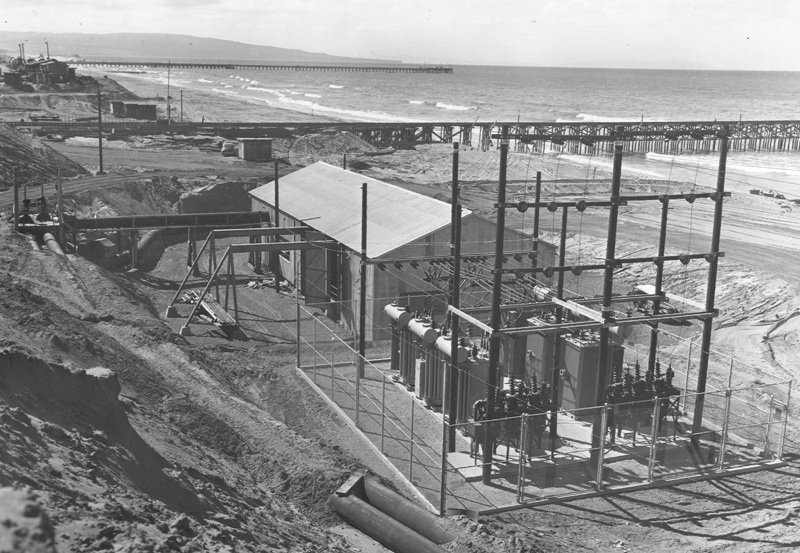
Construction of the Hyperion Sewage Treatment Plant. The new sewage screening plant, completed in 1950, replaced an aging plant built in 1924—a view looking south at the transformer substation and pump house. The construction pier is in the background, and the Standard Oil Refinery pier is south. West of construction is the Pacific Ocean, and east is El Segundo.
#37 Macy Street Viaduct and Bridge sign, 1923
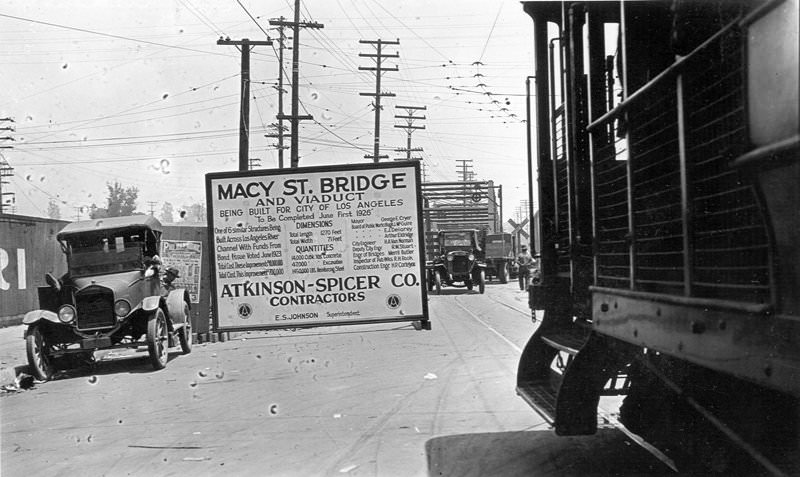
Atkinson-Spicer Company Contractors construction sign for the Macy Street Viaduct and Bridge. Among a group of 12 river bridges, Macy Street is notable for its role in the transport history of Los Angeles and its association with Chief Engineer Merrill Butler, a prominent bridge designer at the time. Macy Street provided an unimpeded crossing at high water for northern and eastern sections of the rapidly developing city to access the city.
#38 Eysian Park Reservoir, 1923
#39 Bell Air Bridge, 1924
#40 Avenue 60, Old Bridge, 1924
#41 Franklin Avenue Bridge, 1925
#42 Bell Air Bridge, Nimes Road looking north, August 24, 1925
#43 Construction under Universal City Bridge for Carl Laemmle’s Universal City Pictures on the former Taylor Ranch in Lankershim Township.
#44 Bell Air Bridge and Nimes Road, 1925
#45 ujunga Cumston Bridge, 1925
#46 Old State Street Bridge, 1925
#47 Avenue 60, Old Bridge, 1925
#48 Sunset Boulevard Road Cut, 1925
#49 Old State Street Bridge, 1925
#50 Tujunga Valley Avenue Bridge across Little Tujunga Wash, 1925
#51 Tropico Bridge, Los Feliz Boulevard, 1925
#52 Avenue 60, New bridge construction, 1925
#53 Avenue 26 Bridge, complete, 1925
#54 Victory Boulevard Bridge at Riverside Drive, 1925
#55 San Fernando Bridge, 1925
#56 Eysian Park Reservoir, 1925
#57 Anaheim Street Bridge, looking north from the south end and on the west side, 1925
#58 Wilshire Boulevard to Veteran Avenue, 1925
#59 Pacific View Drive, looking west from Viso Drive, retaining wall near the junction with Woodrow Wilson Road, 1925
#60 Wilshire Boulevard to Veteran Avenue, crew spreading concrete from trucks, 1925
#61 Old East Fourth Street Viaduct, 1925
#62 Arroyo De La Sacatela storm drain, 1926
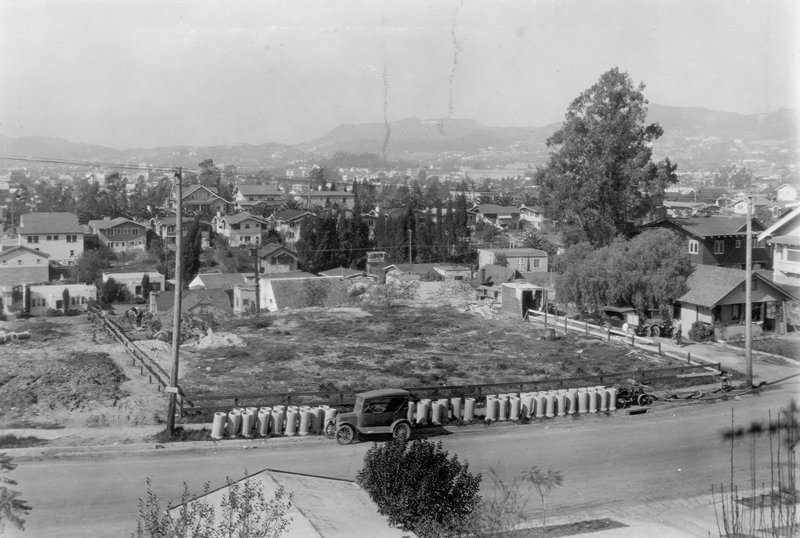
Arroyo De La Sacatela storm drain, which passes through a tunnel. In the early 20th century, Sacatela Creek was a perennial stream in the Franklin Hills and joined Ballona Creek in Koreatown/Mid-City, between Westchester and Country Club Drive. Near today's Beverly Boulevard and Madison Avenue, a seasonal stream flowed into Sacatela Creek from the Silver Lake Reservoir area. In 1929, the storm drain was built in the stream's path, and the creek was filled.
#63 Riverside Drive and Dayton Avenue Viaduct, 1926
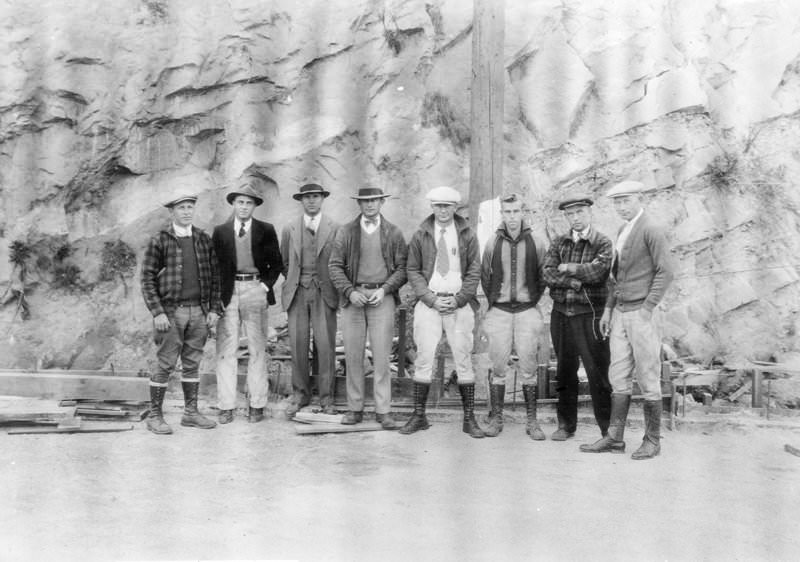
Riverside Drive and Dayton Avenue Viaduct, inspectors, contractors, and employees. It replaced the earlier Dayton Avenue Bridge built-in 1903. Riverside Drive-Dayton Avenue Bridge, alternately known as Riverside Drive-Figueroa Bridge, was renamed when Dayton Avenue was renamed North Figueroa to continue the original Figueroa Street. In 2008, the bridge was designated a Los Angeles Historic-Cultural Monument.
#64 Sunset Boulevard Subgrade, 1926
#65 Wilshire Boulevard to Veteran Avenue, 1926
#66 Wilshire Boulevard to Veteran Avenue, 1926
#67 Woodrow Wilson Road, 1926
#68 Sacatela Storm Drain, 1926
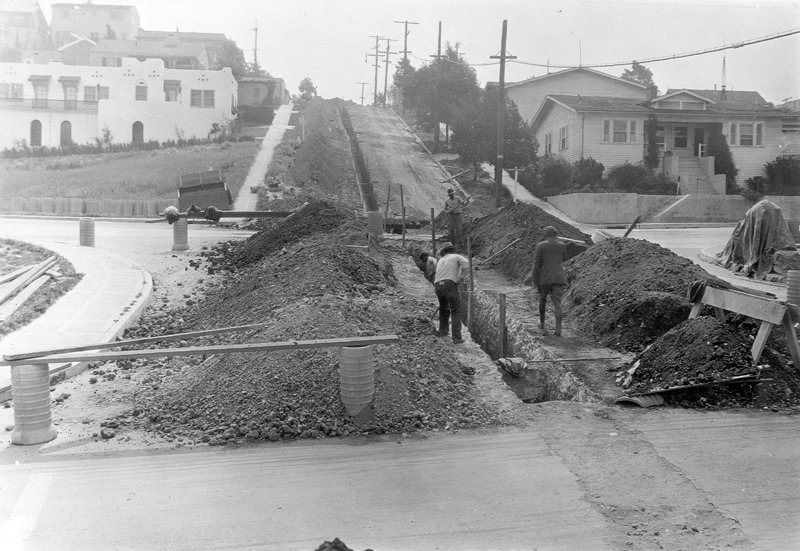
The Arroyo de la Sacatela storm drain is seen from Effie Street at Silverlake's west end. Sacatela Creek (also called Bimini Slough) and Bimini Hot Springs, a perennial stream from Franklin Hills, joined Ballona Creek in Koreatown/Mid-City between Wilton, Westchester and Country Club Drive formed the storm drain. The creek was filled after the storm drain was completed. A photograph shows a ditch with vertical dirt walls on both sides and wooden poles and planks in the left foreground. Each side of the ditch has piles of dirt. You can see telephone poles in the right background, while houses can be seen on both sides of the ditch. Two men are working on the storm drain.
#69 Fourth Street Viaduct, 1926
#70 Old East Fourth Street viaduct, 1926
#71 Pacific View Drive, 1926
#72 Fourth Street viaduct, 1926
#73 Old East Fourth Street viaduct, 1926
#74 Mulholland Highway and Cahuenga Boulevard, 1926
#75 First Street Viaduct, 1926
#76 Wilshire Boulevard to Veteran Avenue, 1926
#77 Aldama Street, 1926
#78 Pacoima Avenue bridge, 1926
#79 Old East Fourth Street viaduct, 1929
#80 Fourth Street and Mateo Street, 1929
#81 Wilshire Boulevard to Veteran Avenue, 1929
#82 Automobile Wreck, 1929
#83 Cahuenga Boulevard Sanitary Sewer Construction, 1927
#84 Verdugo and Glassell Avenue Sewer Pipe, 1927
#85 Pico Street Bridge, 1927
#86 Verdugo Road and Glassell Avenue storm drain, 1927
#87 Cahuenga Surfacing and Grading, 1927
#88 Laurel Canyon storm drain, 1927
#89 East First Street Viaduct, 1927
#90 View from Hyperion-Glendale Bridge, 1927
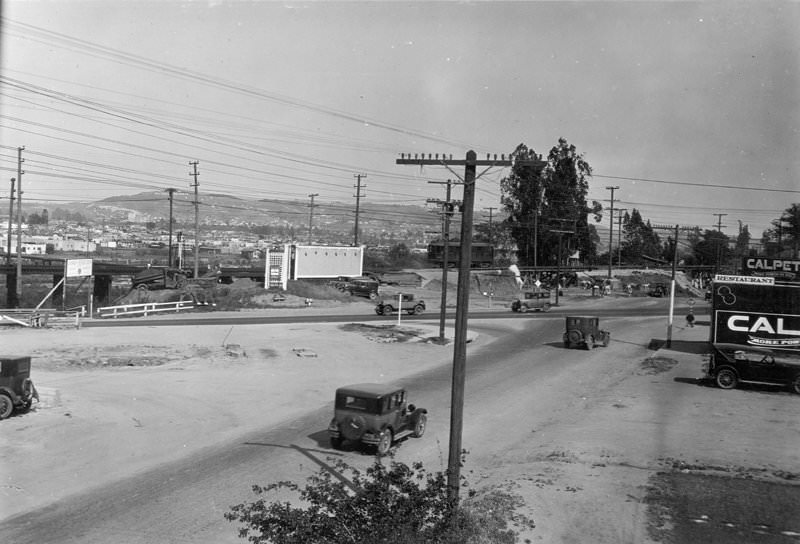
During construction of the Hyperion-Glendale Bridge, looking east towards Riverside Drive. The Glendale-Hyperion Viaduct is 56 feet wide, 1,340 feet long, and has thirteen concrete arches. Listed as a Los Angeles Historic-Cultural Monument in 1976, the bridge was designed by Merrill Butler. He was the city's chief bridge engineer during the 1920s and built most of the city's historic bridges.
#91 Glendale Hyperion Viaduct looking north, 1927
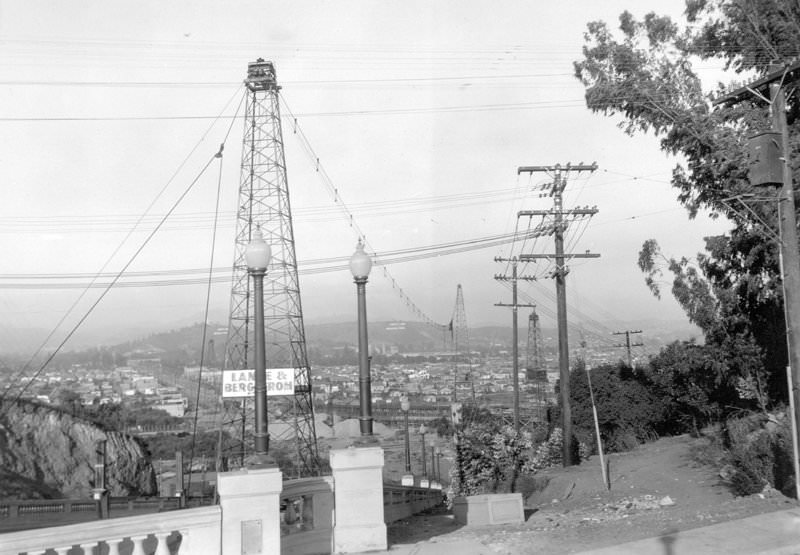
Glendale-Hyperion Viaduct seen from the end of Waverly Avenue Bridge. A Los Angeles Historic-Cultural Monument since 1976, the bridge was designed by Merrill Butler. He served as the city's chief bridge engineer in the 1920s and built most of the city's historic bridges still standing. The Glendale-Hyperion Viaduct and Bridge is 56 feet wide and 1,340 feet long. It was completed in 1928, and it has thirteen concrete arches.
#92 Cahuenga Boulevard Storm drain, 1927
#93 Verdugo Road and Glassell Avenue Storm Drain, 1927
#94 Peat Left from Fire, 1927
#95 Arroyo Seco Excavation, 1927
#96 Fletcher Drive Bridge, 1927
#97 Dayton Avenue Bridge, 1927
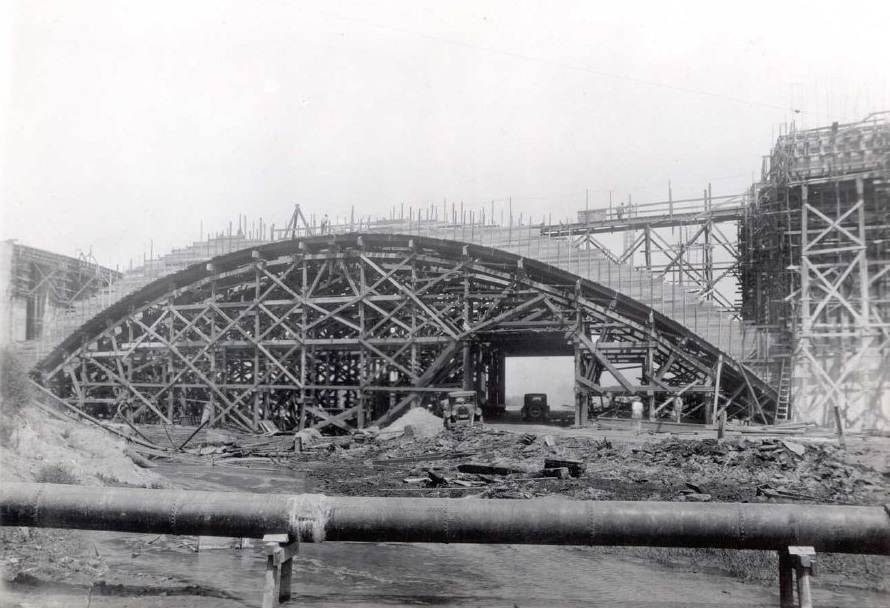
Viaduct and bridge over Dayton Avenue. View of the Main span from the downstream point in the stream bed. The concrete bridge replaced the earlier 1903 Dayton Avenue Bridge. Later, the bridge was renamed Riverside Drive-Dayton Avenue Bridge, or Riverside Drive-Figueroa Bridge, when Dayton Avenue became North Figueroa as a continuation of original Figueroa Street.
#98 Redesdale Avenue looking northeast over Silver Lake, 1927
#99 Verdugo Road Removal of Old Culvert, 1927
#100 Old North Spring Street Bridge, 1927
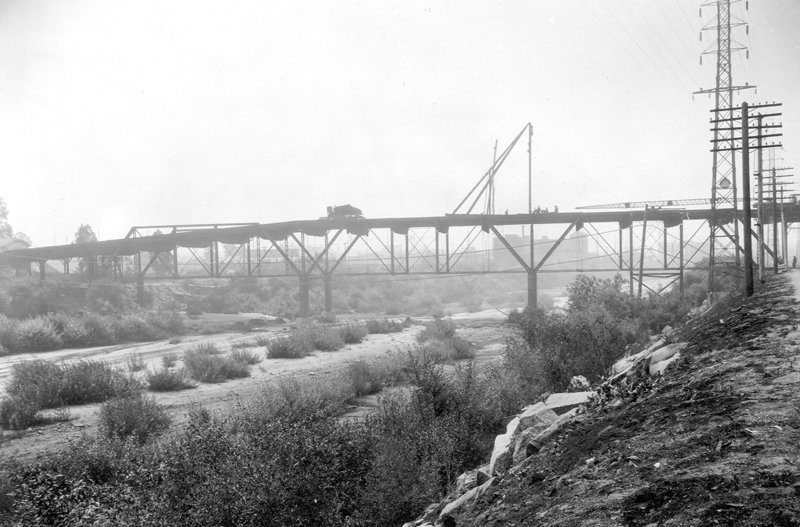
Looking downstream from the old North Spring Street Bridge called Downey Avenue Viaduct initially. A photo taken during construction of the New Spring Street bridge shows the Downey Avenue bridge built shortly after the Macy Street bridge. Downey Avenue is presently a portion of North Broadway east of the Los Angeles River.


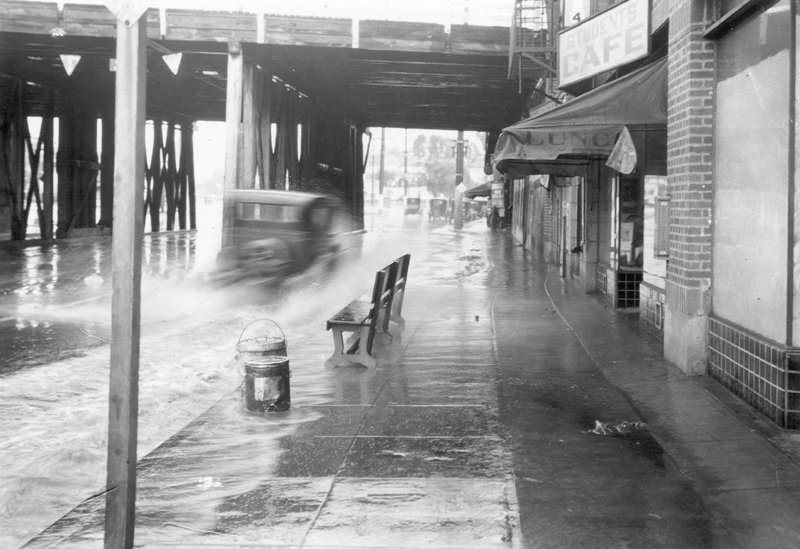
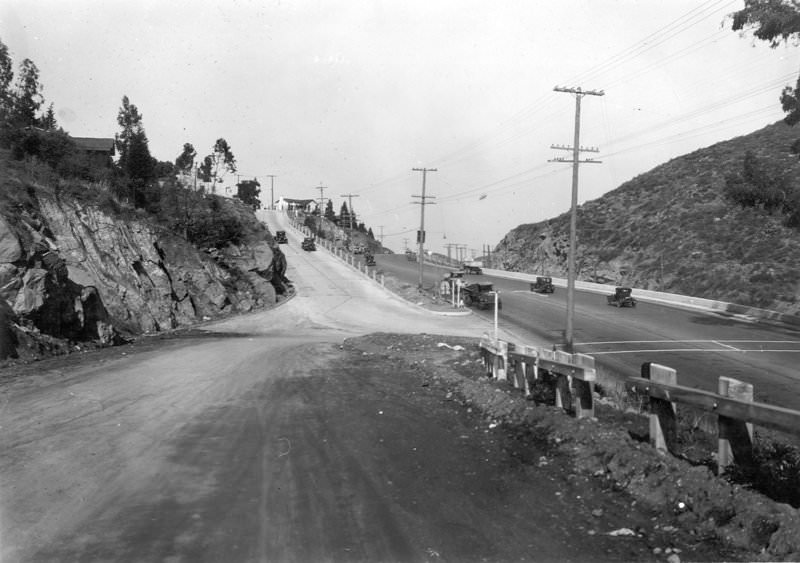
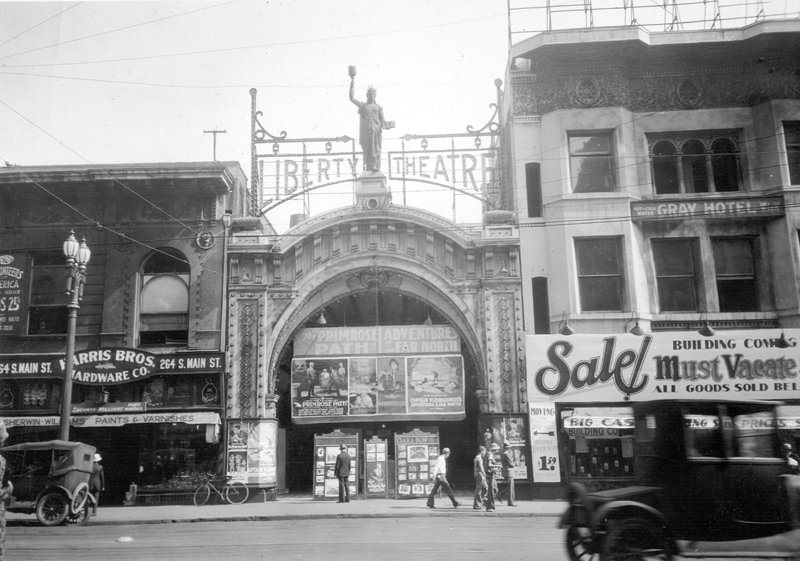
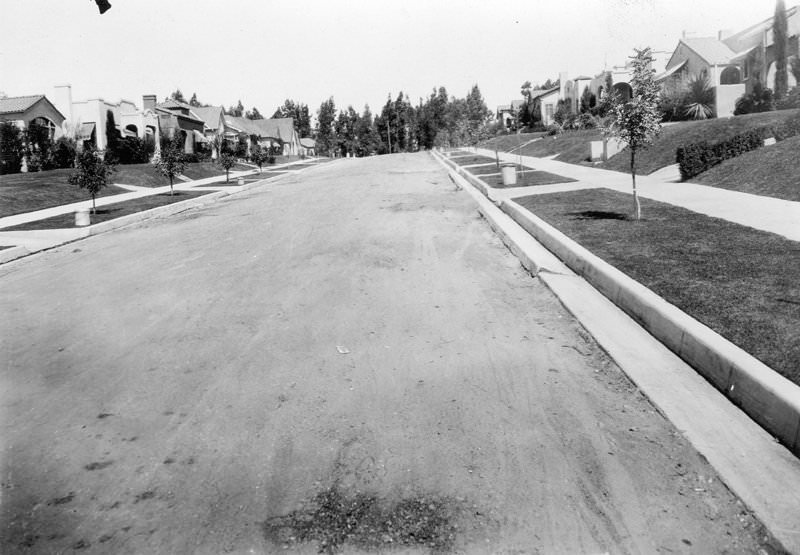
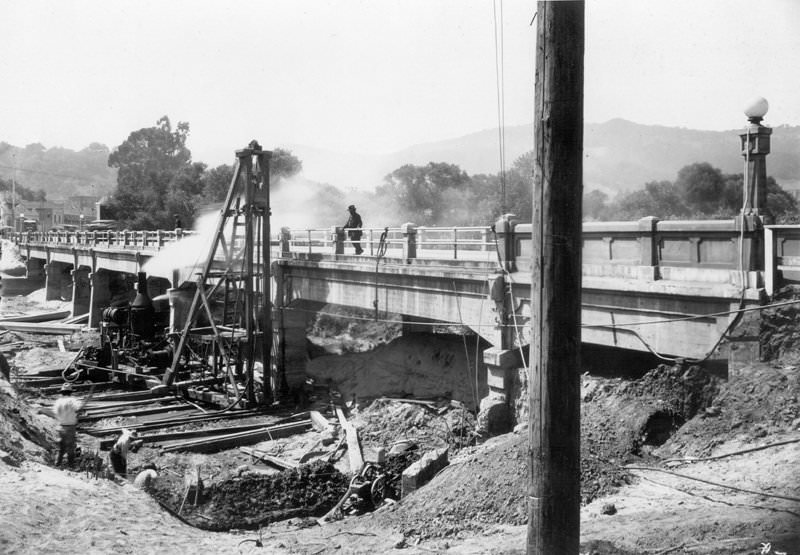
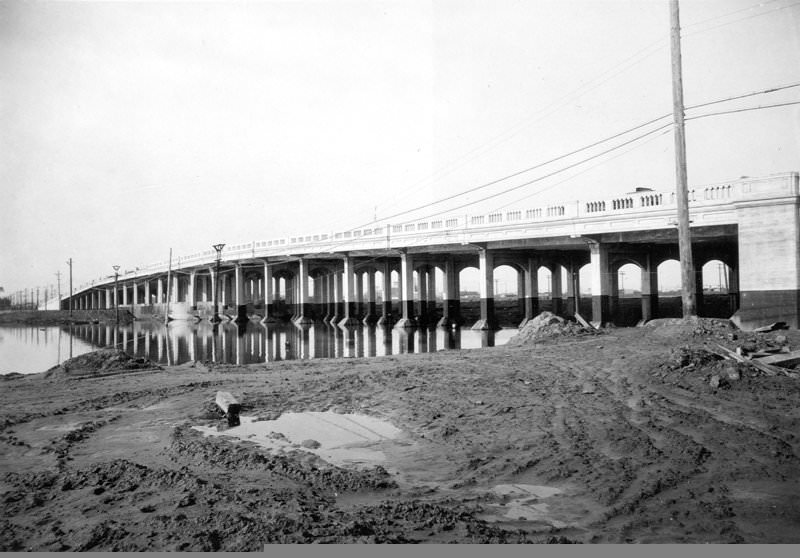
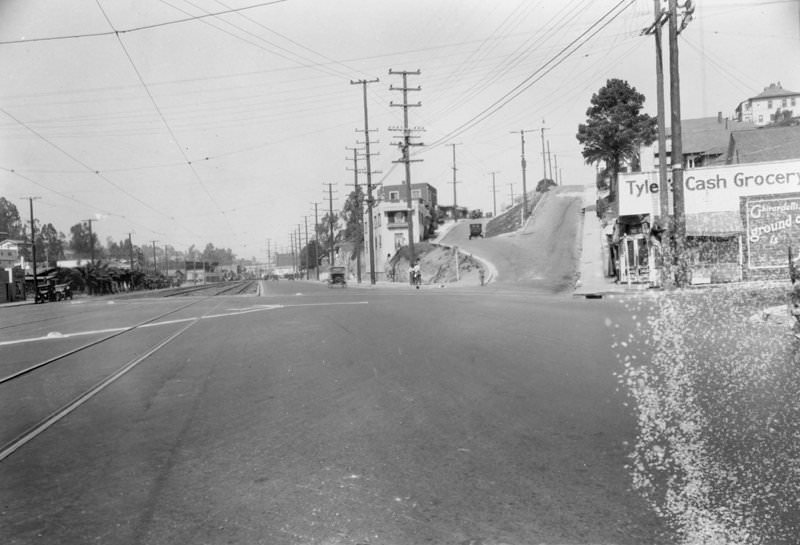
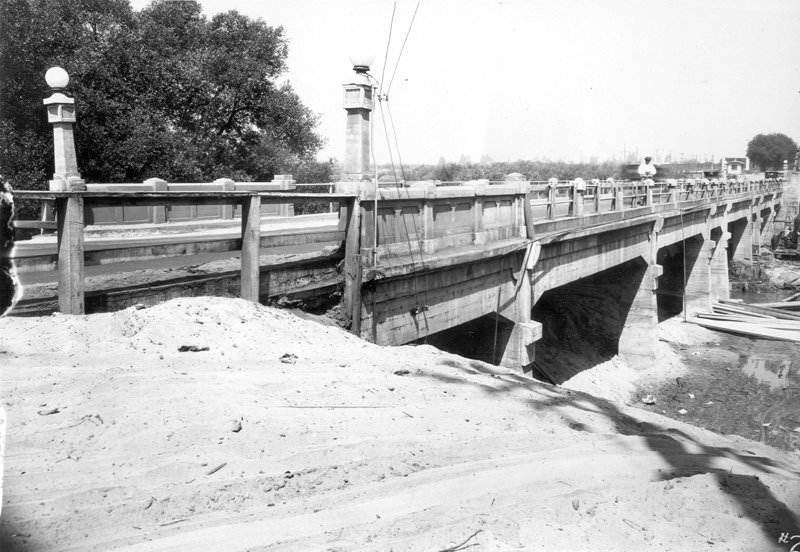
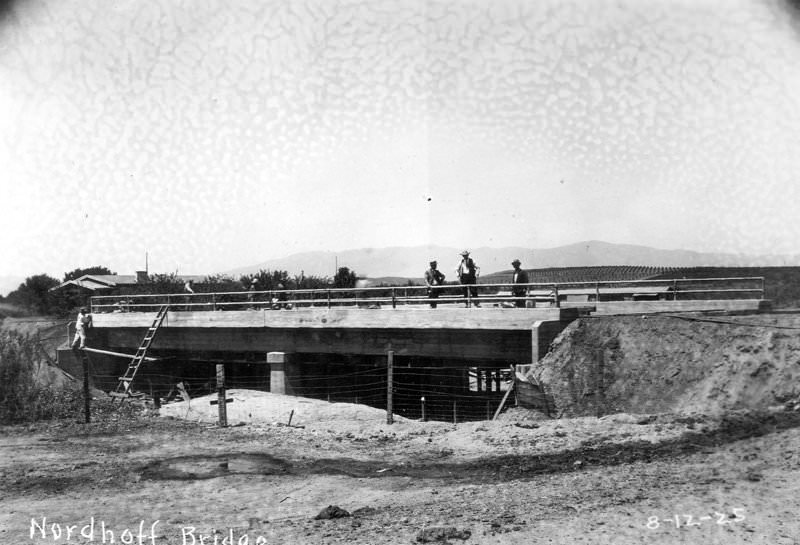
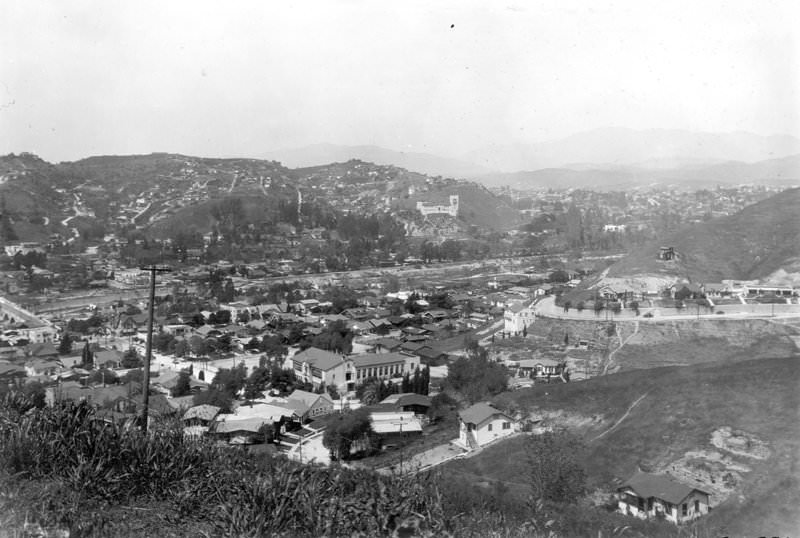
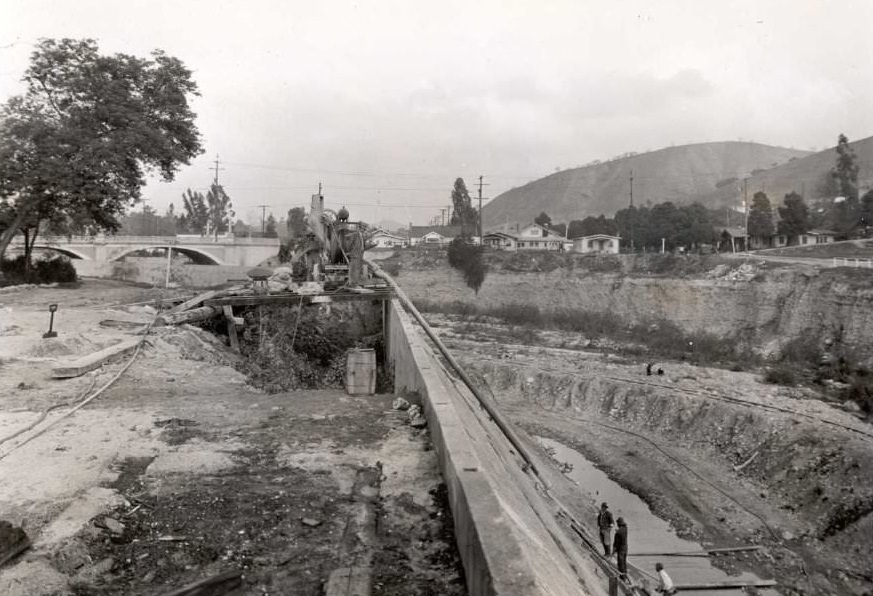
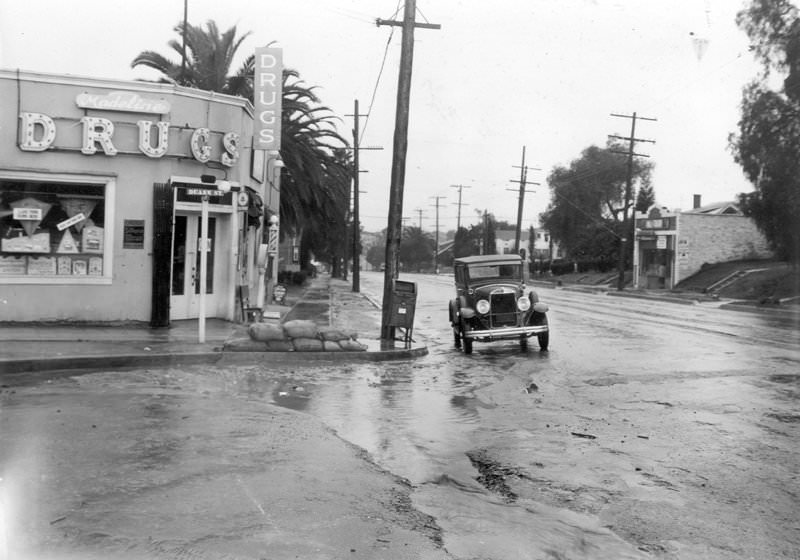
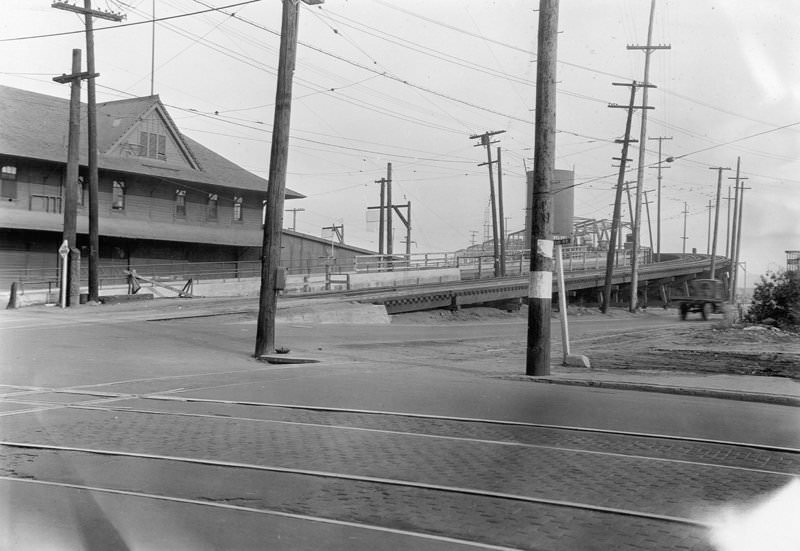
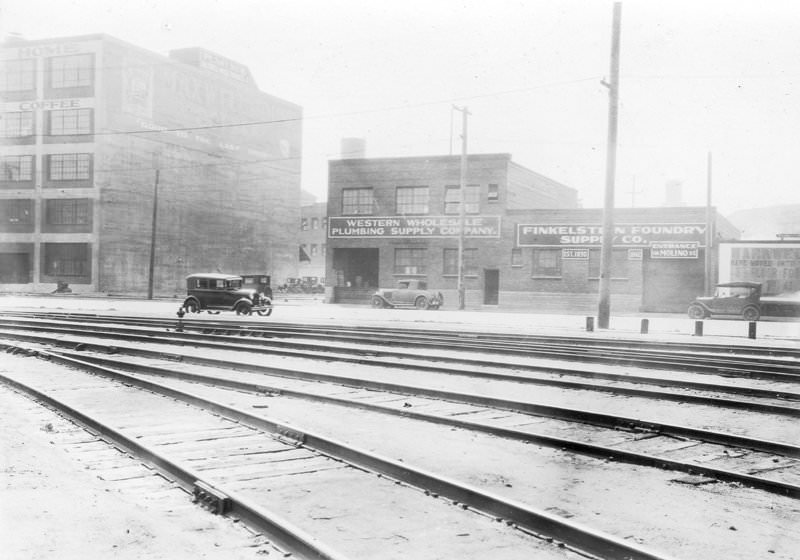
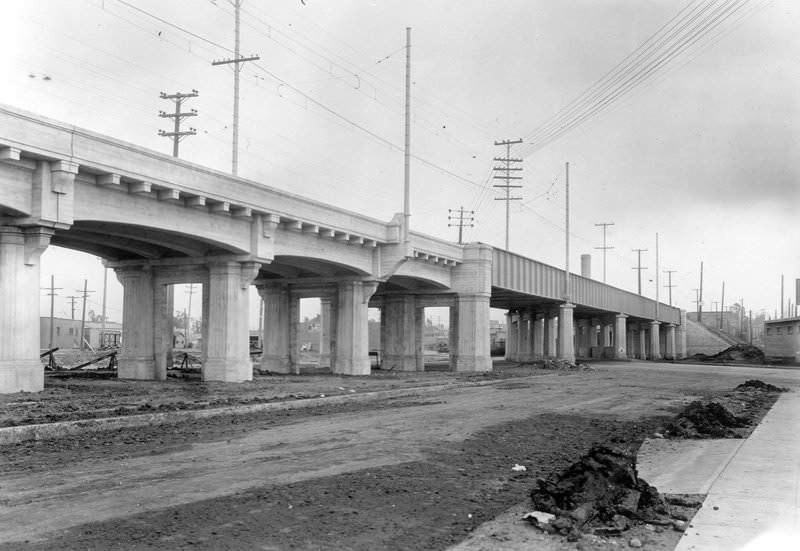
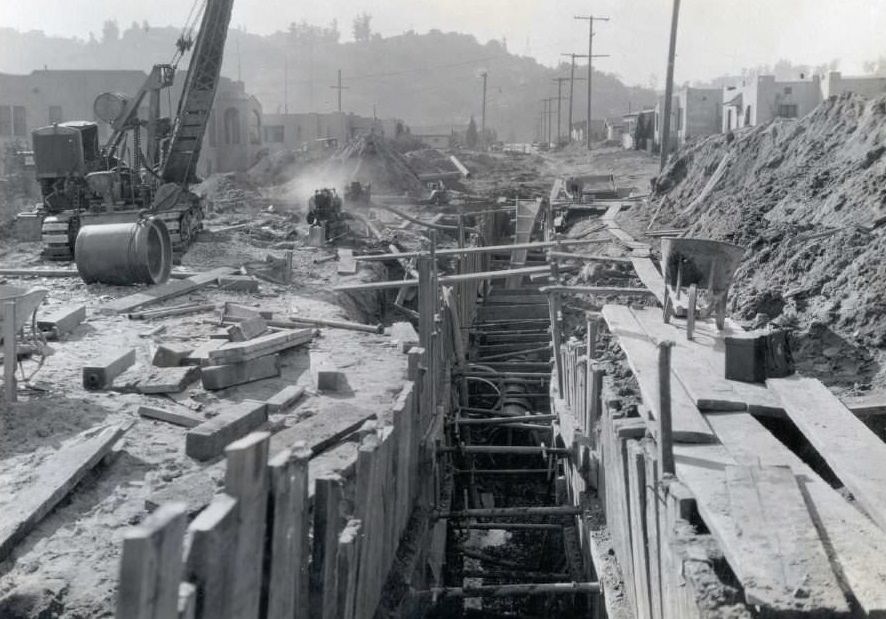
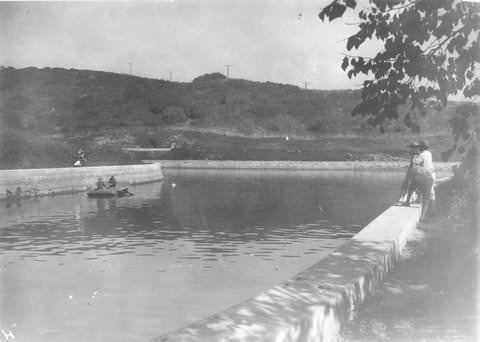
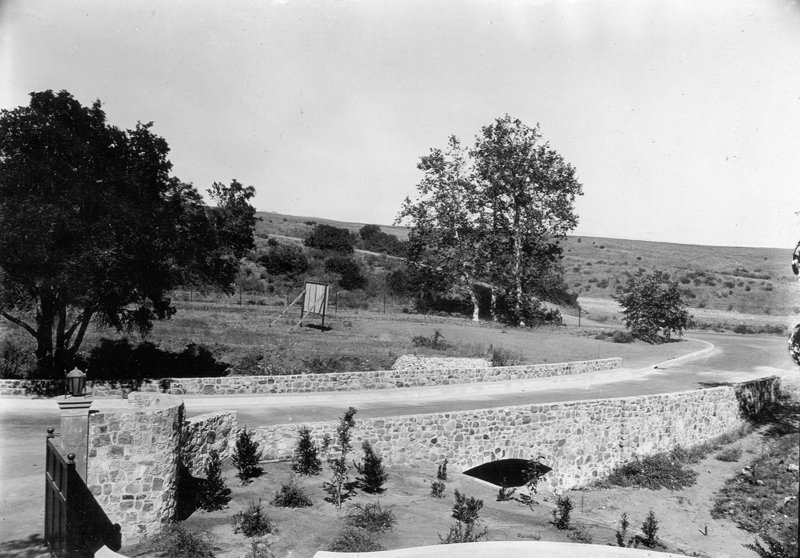
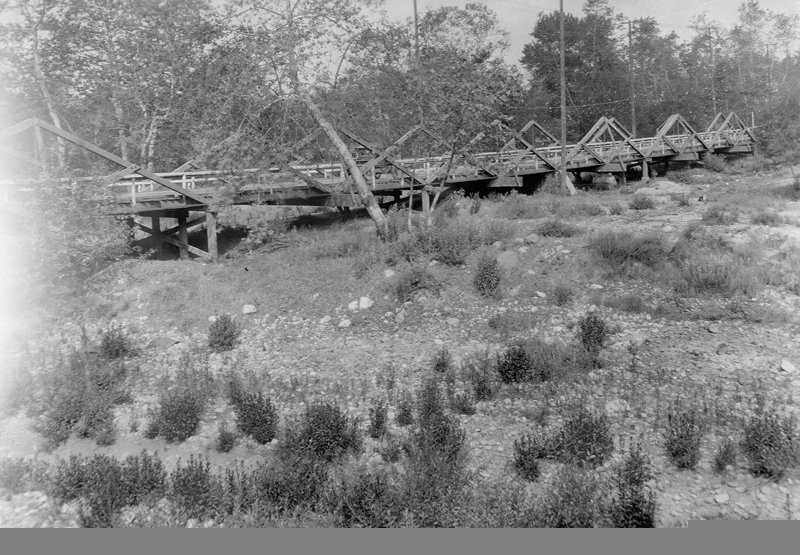
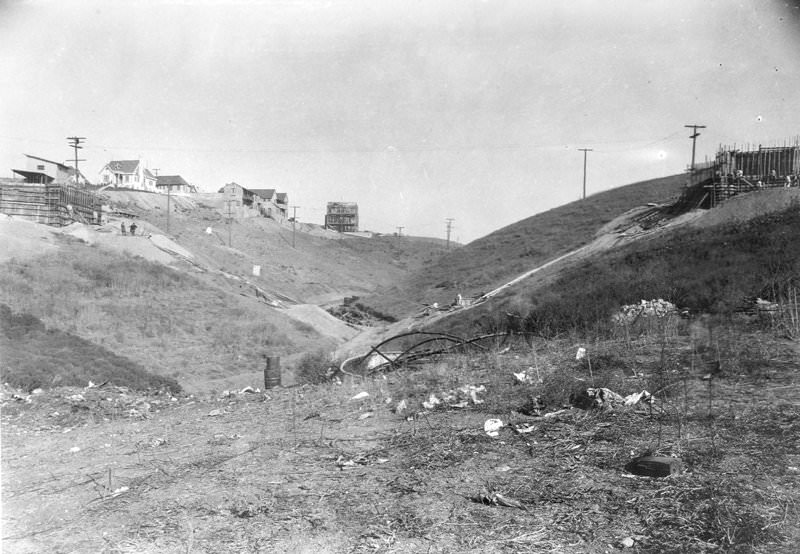
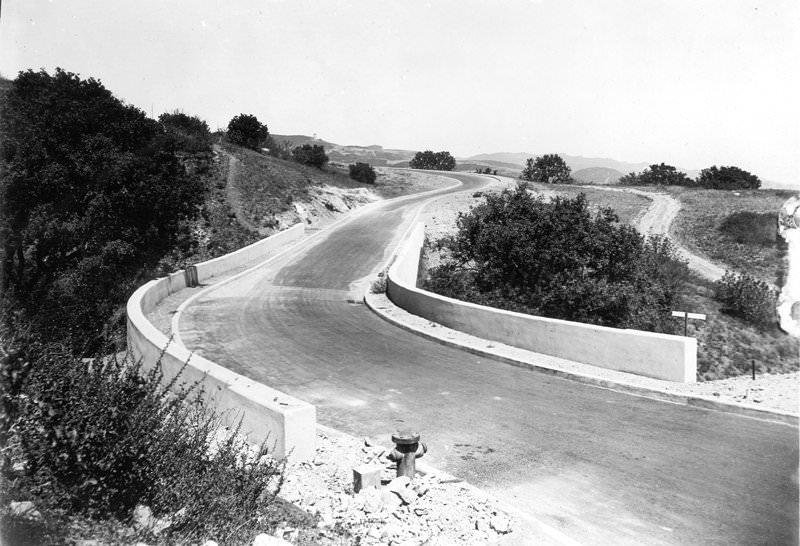
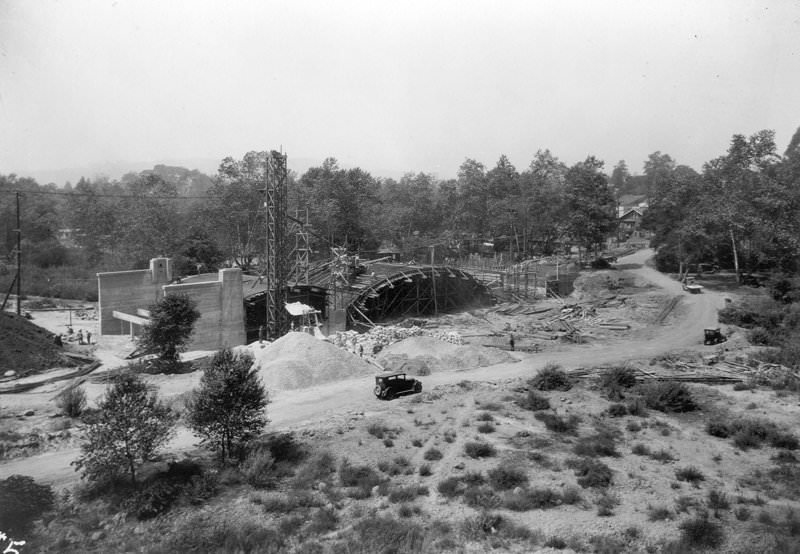

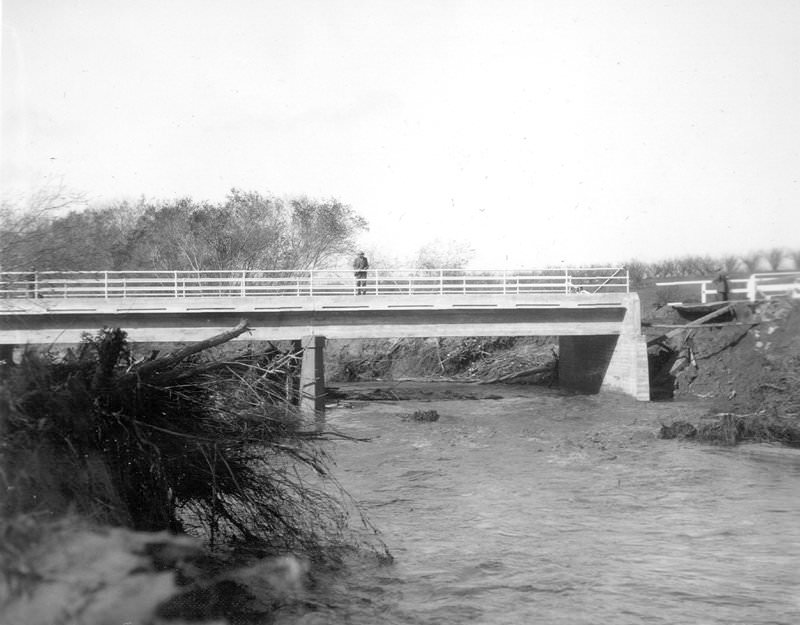
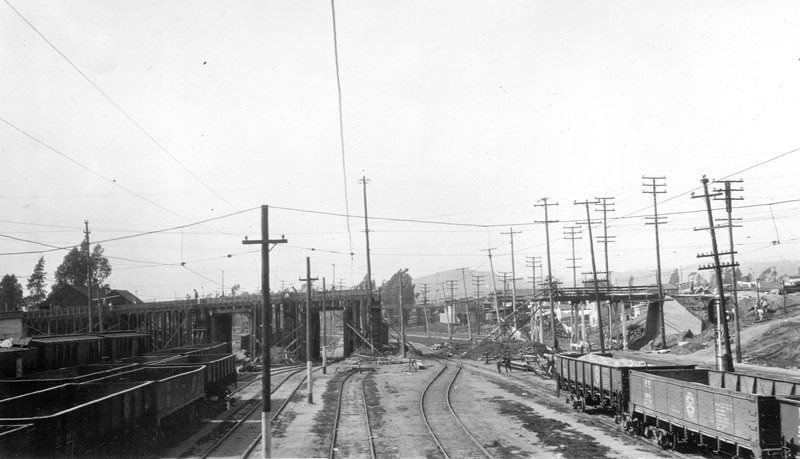
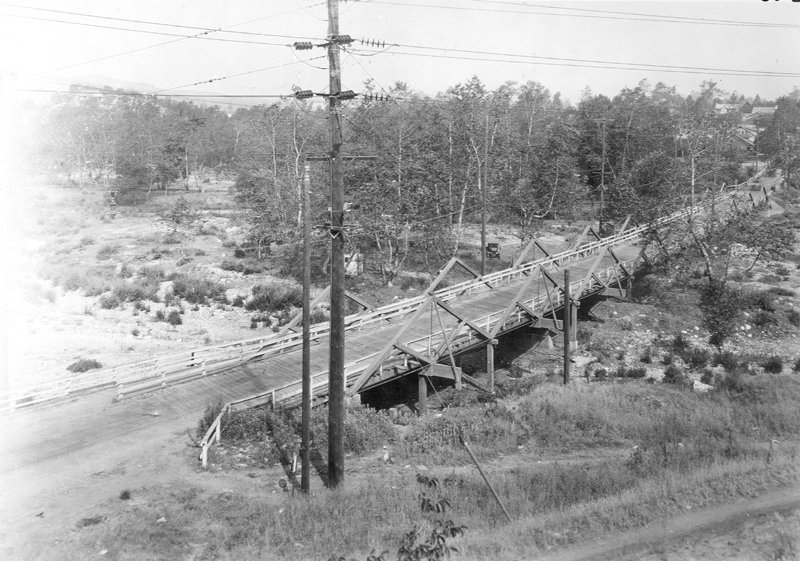
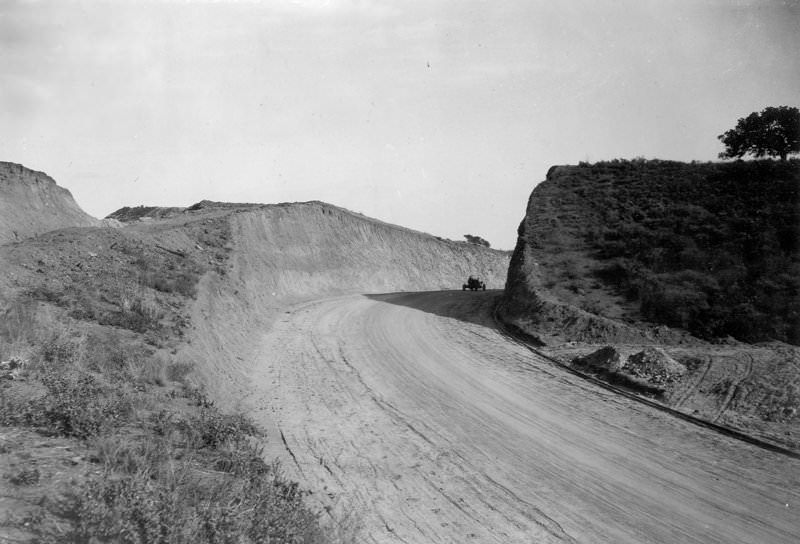
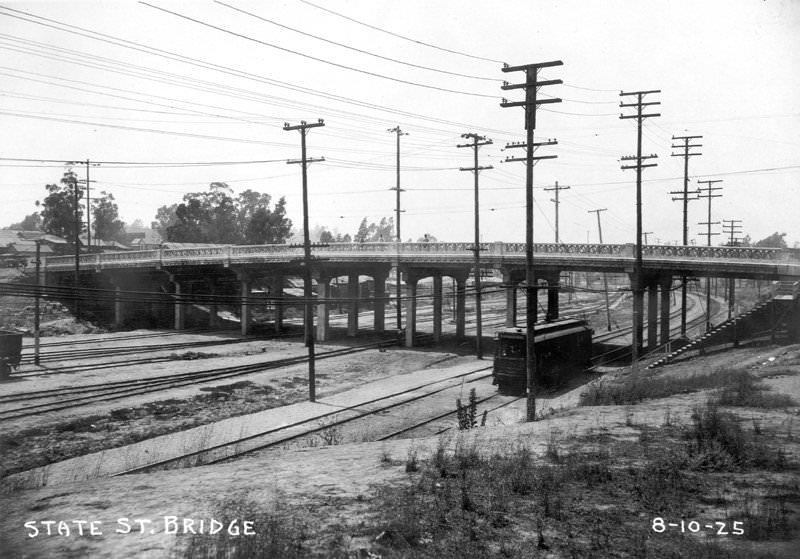
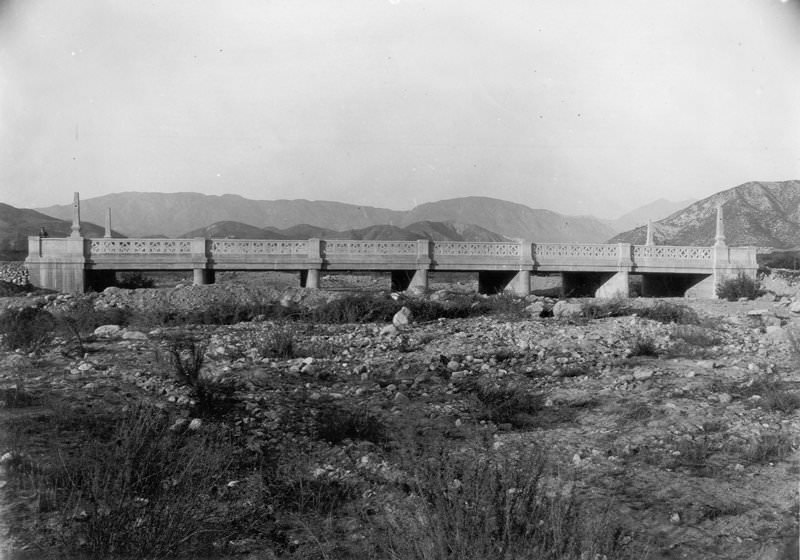
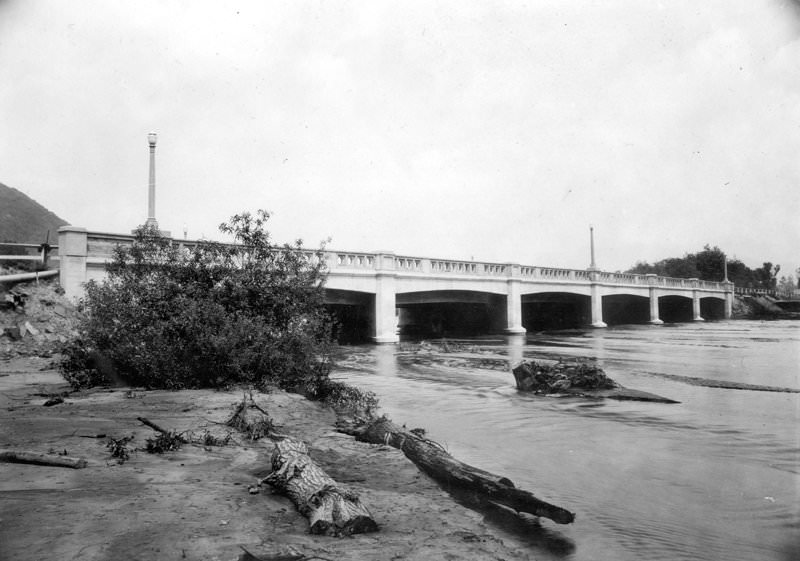
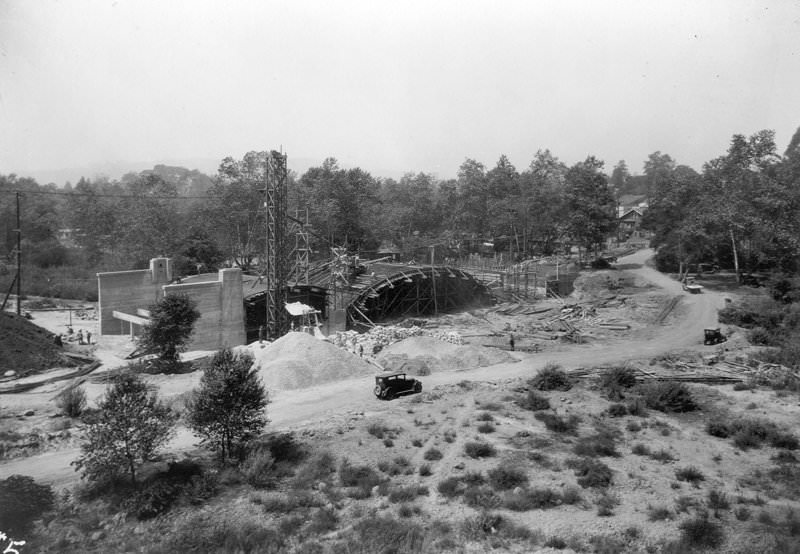
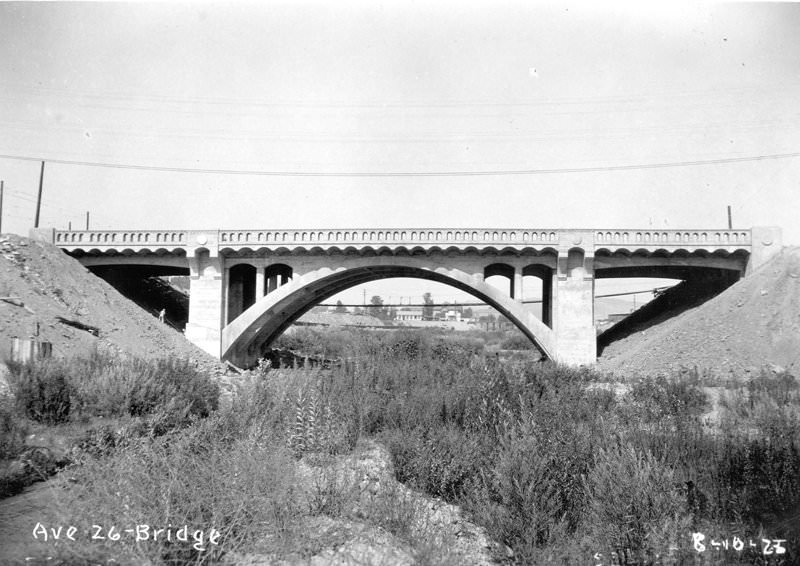
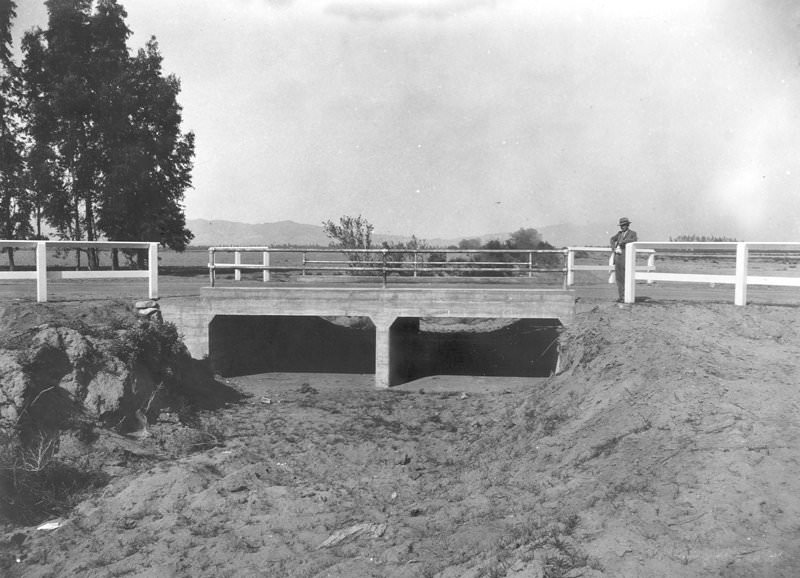
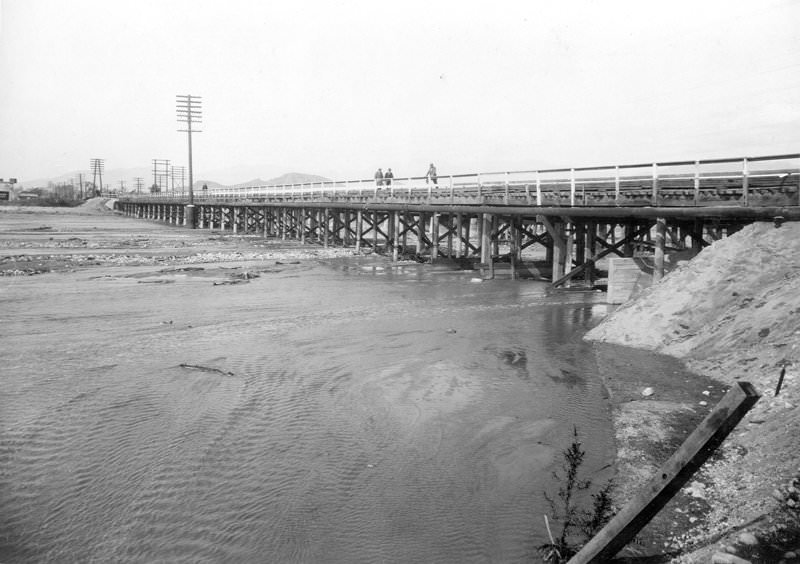
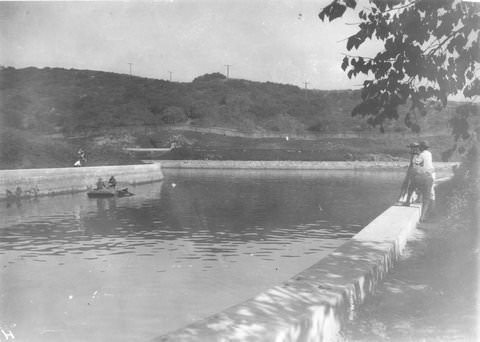
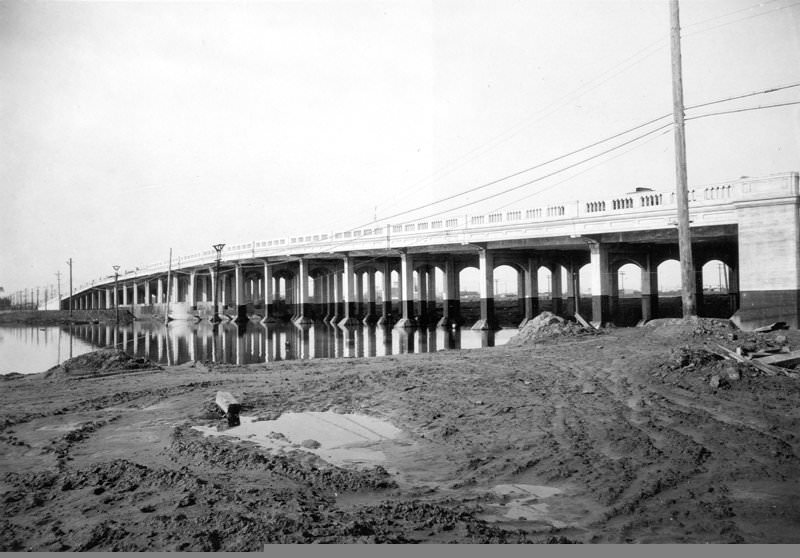
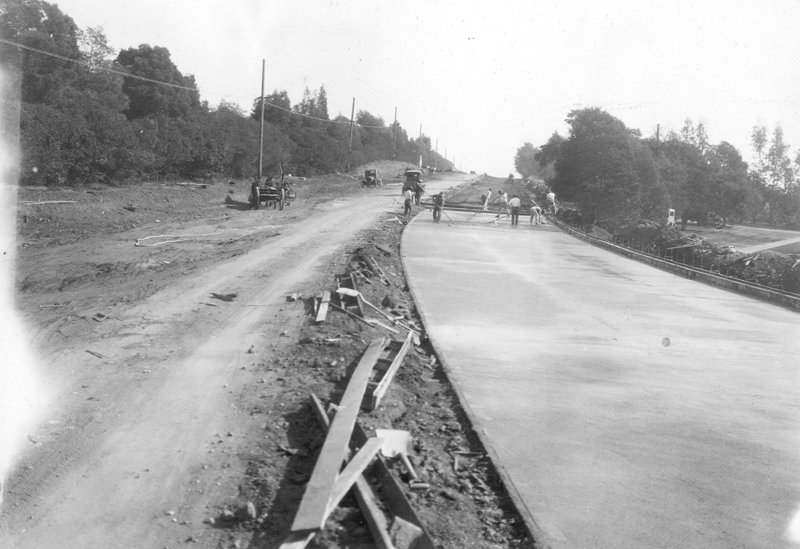
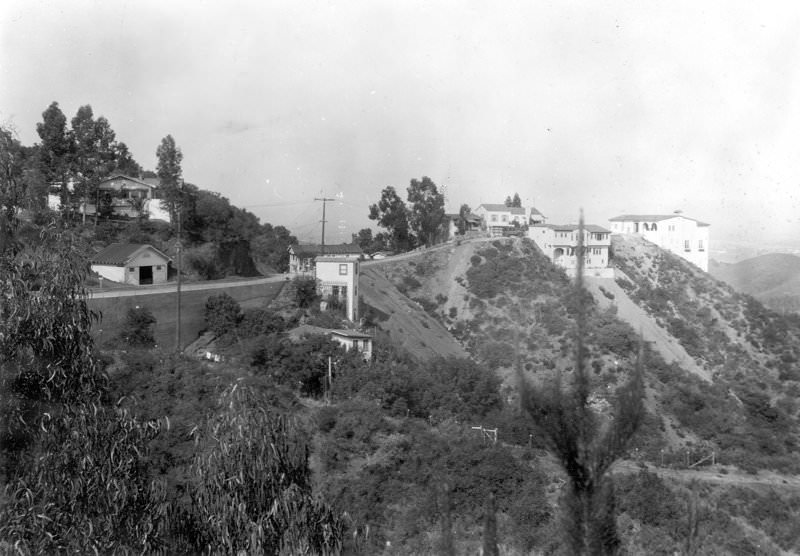
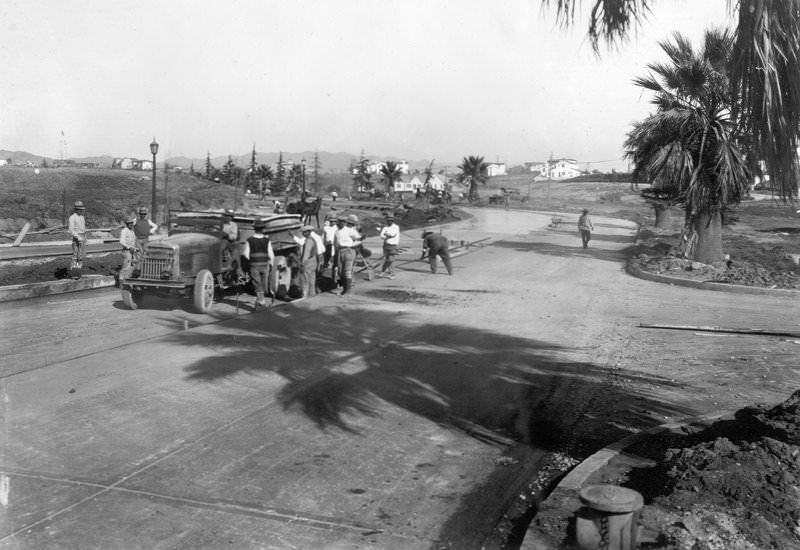
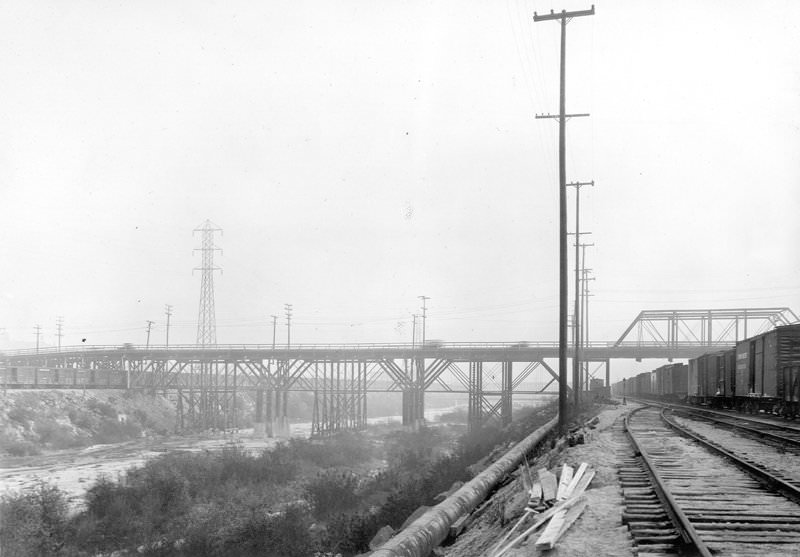
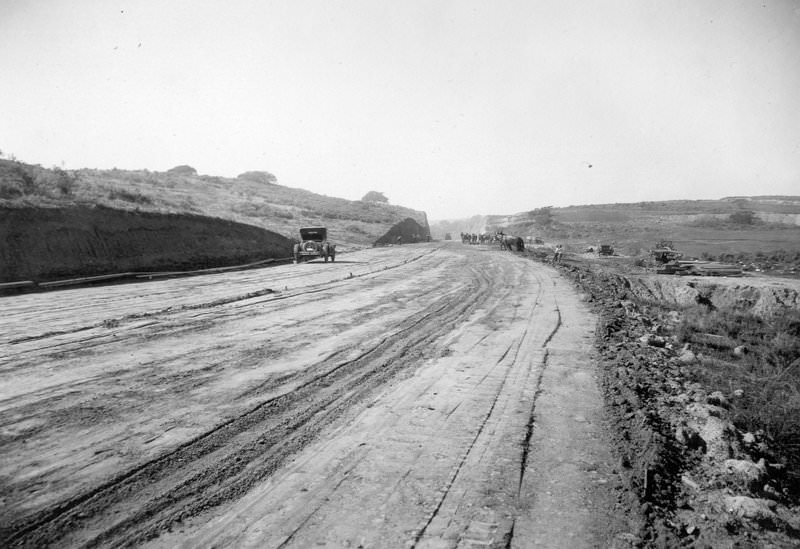
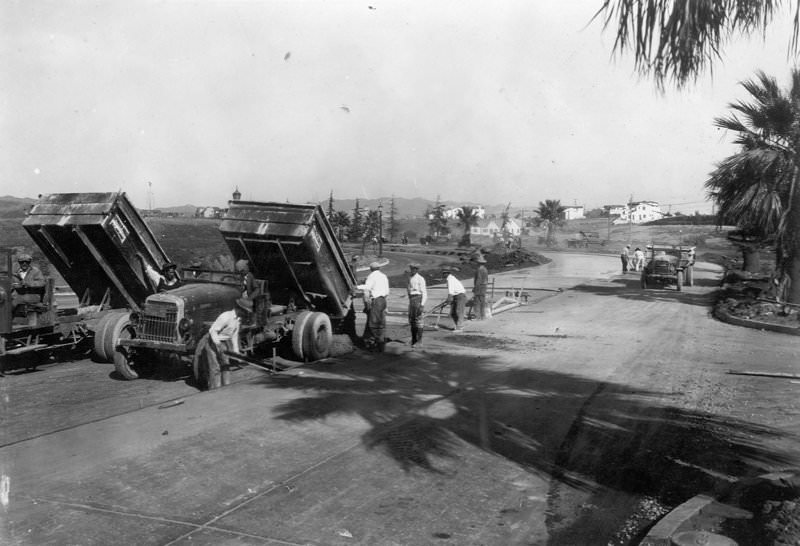
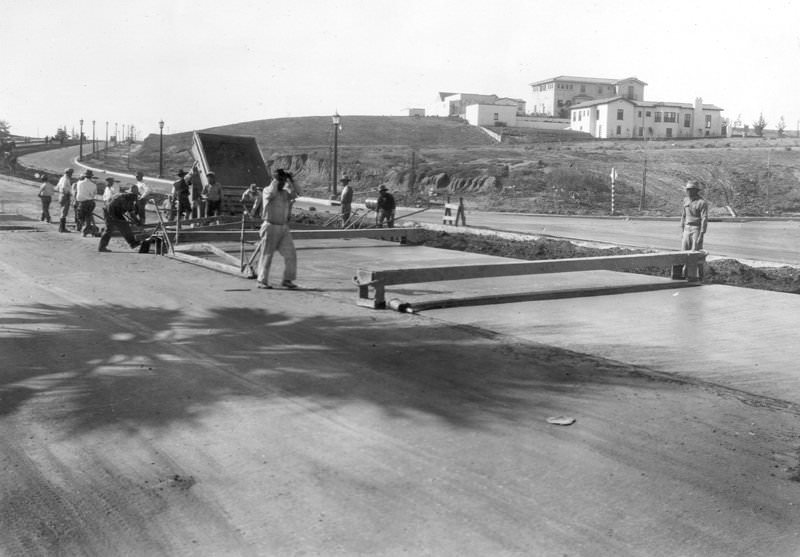
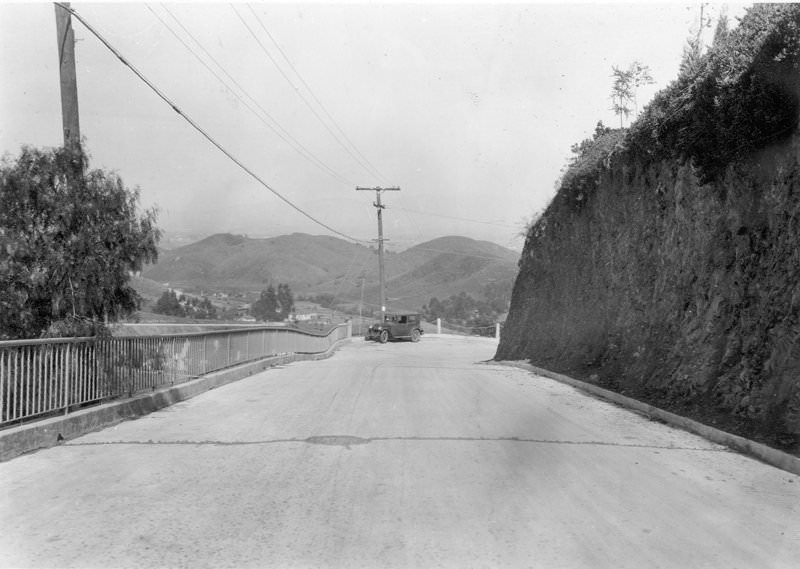
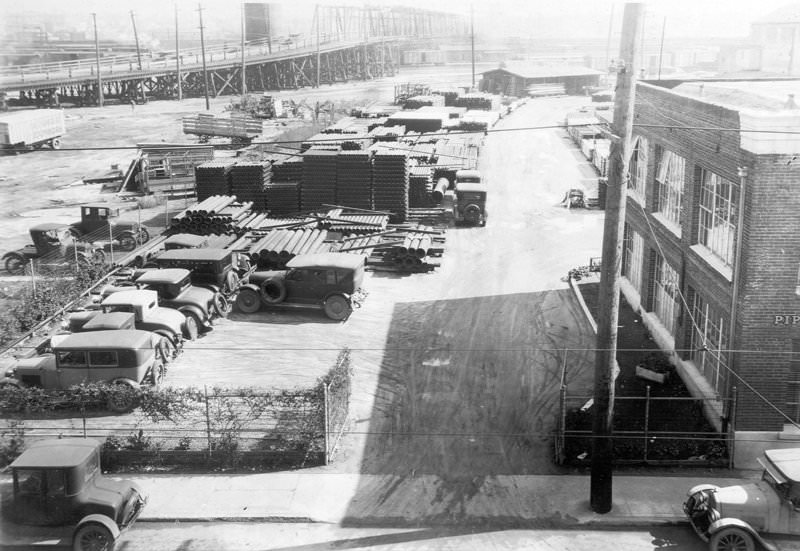
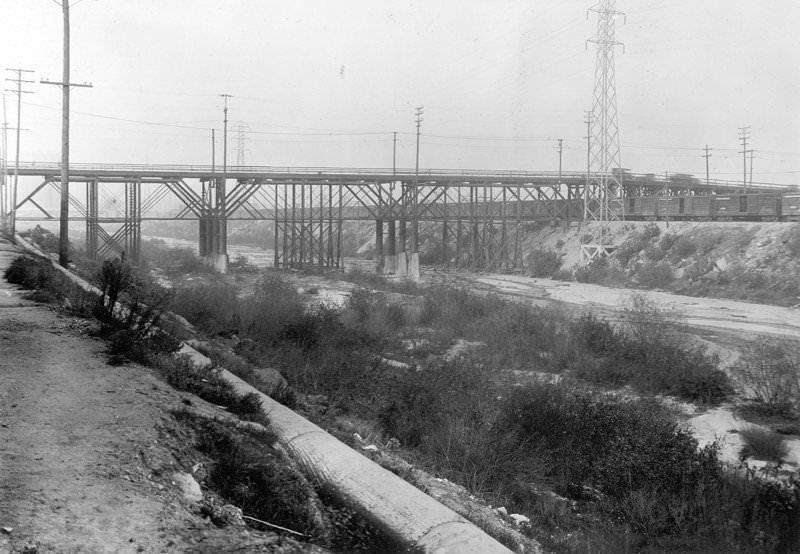
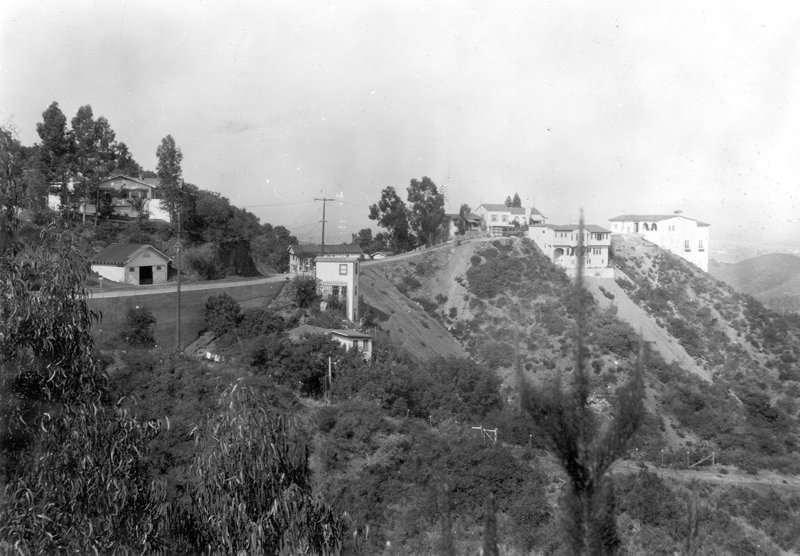
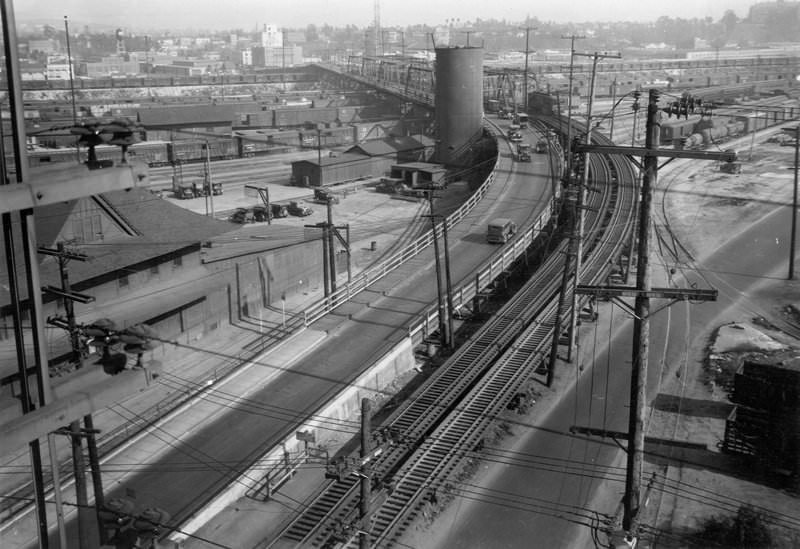
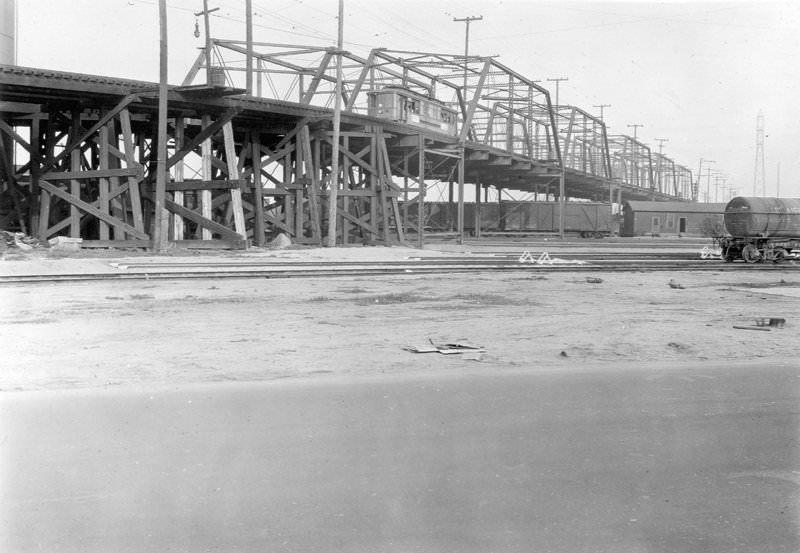
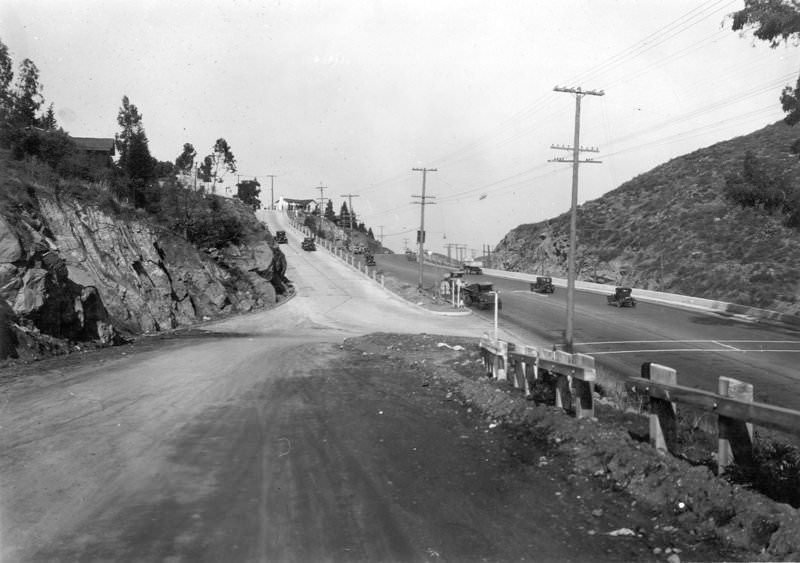
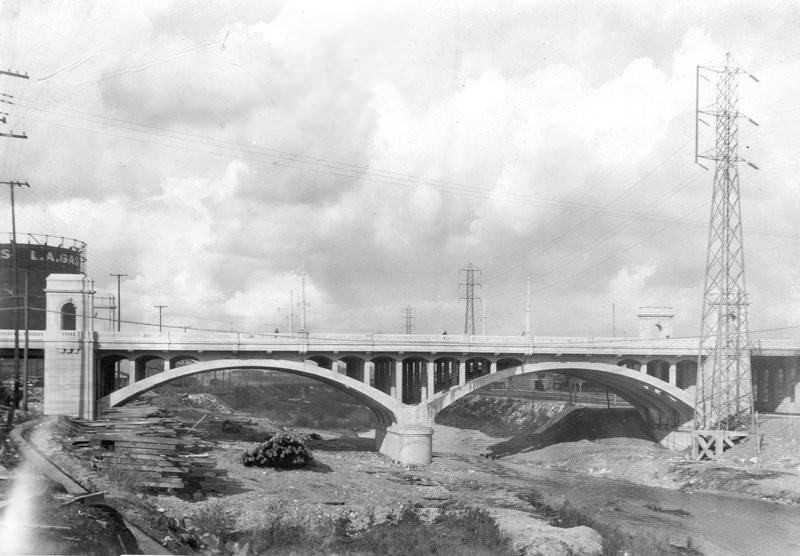
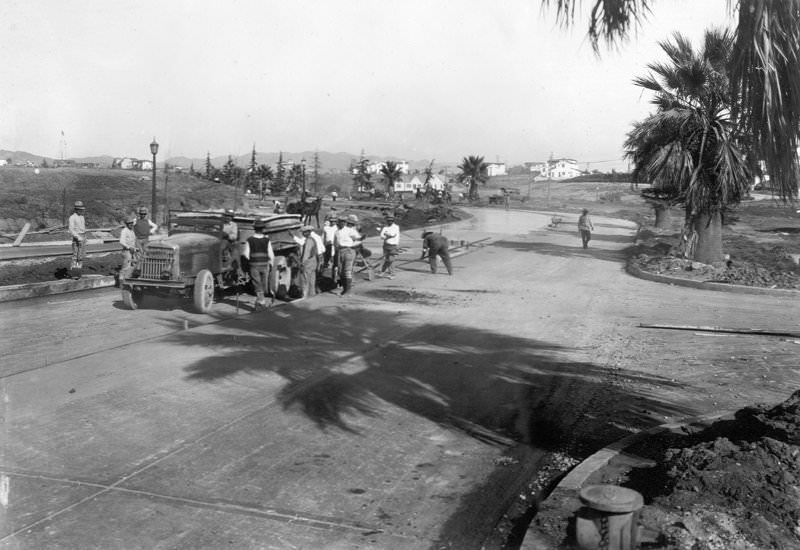
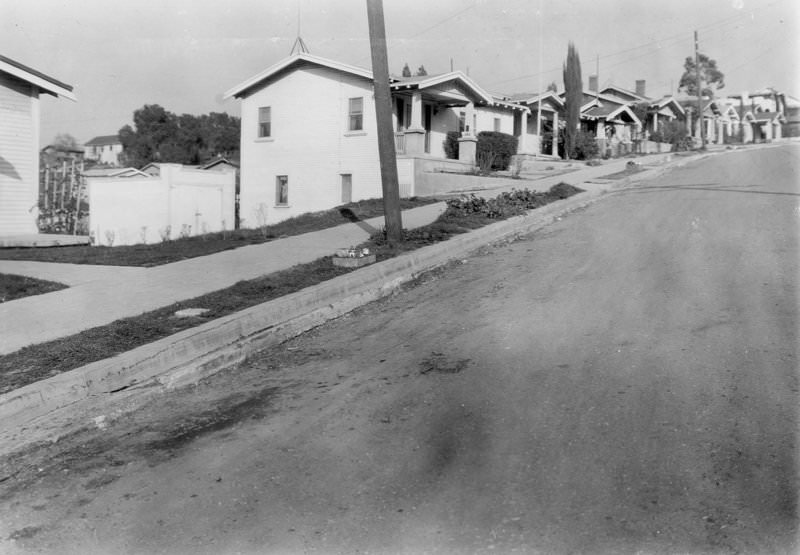
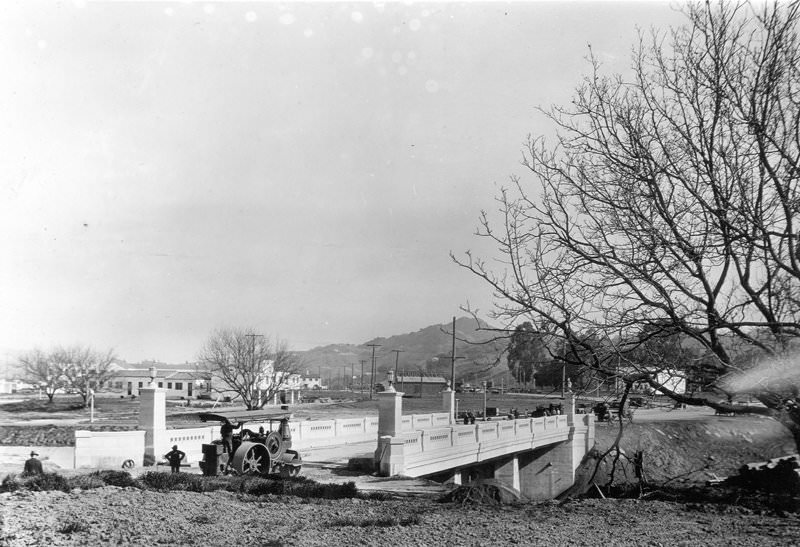
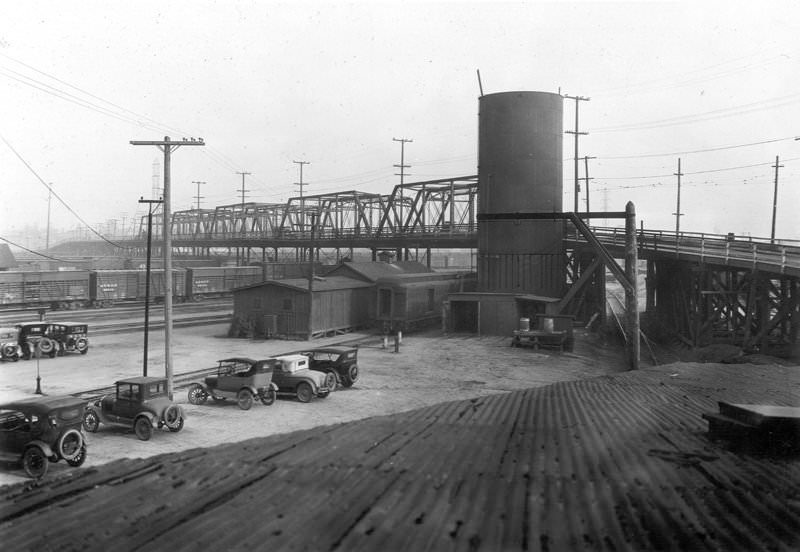
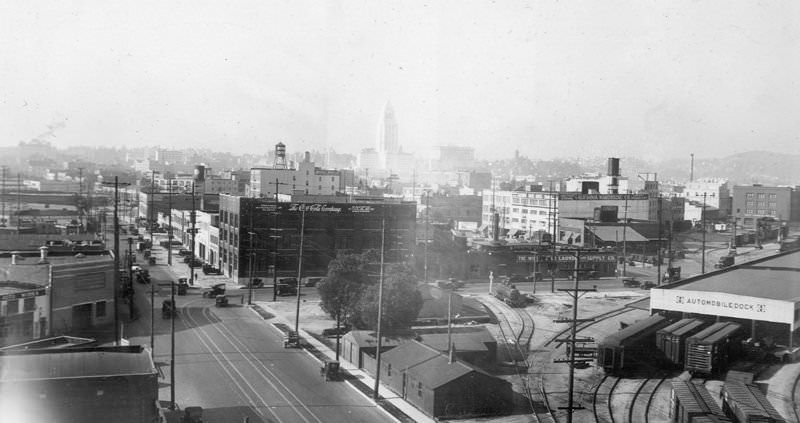
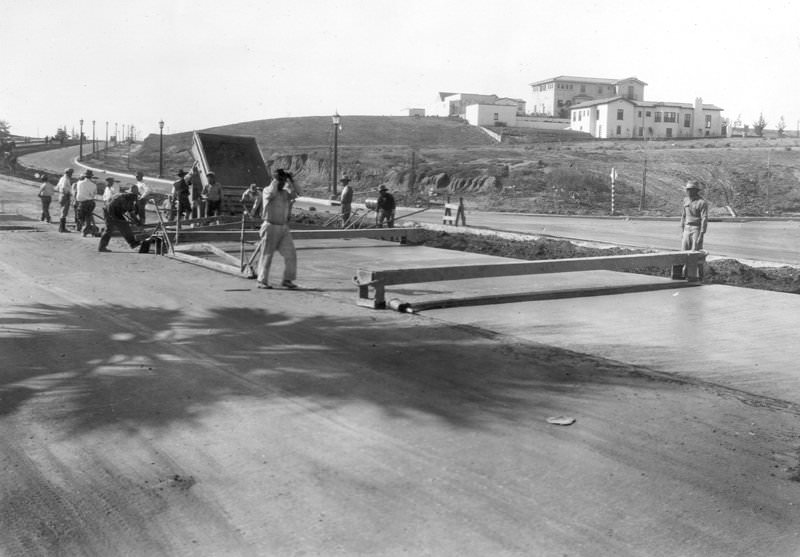
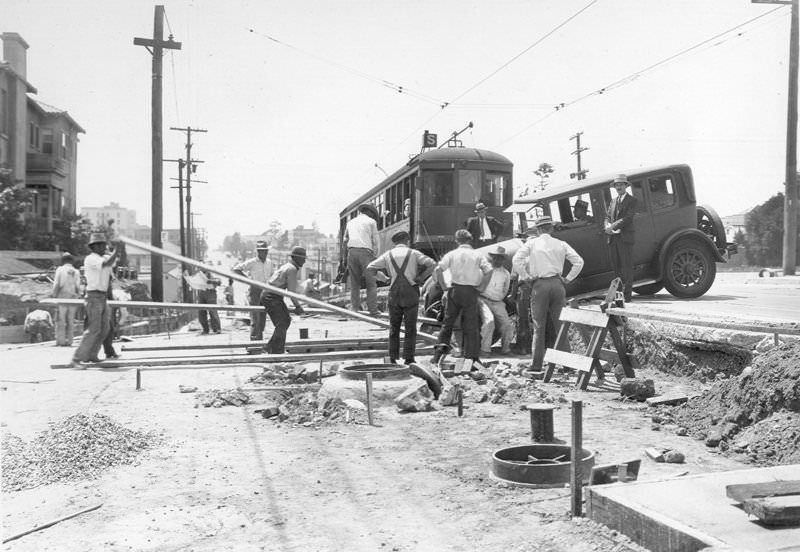
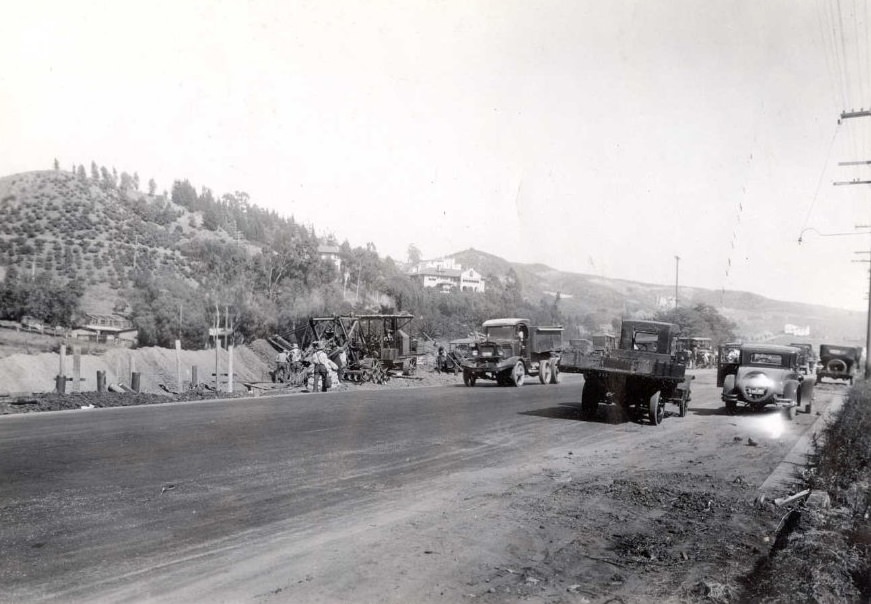
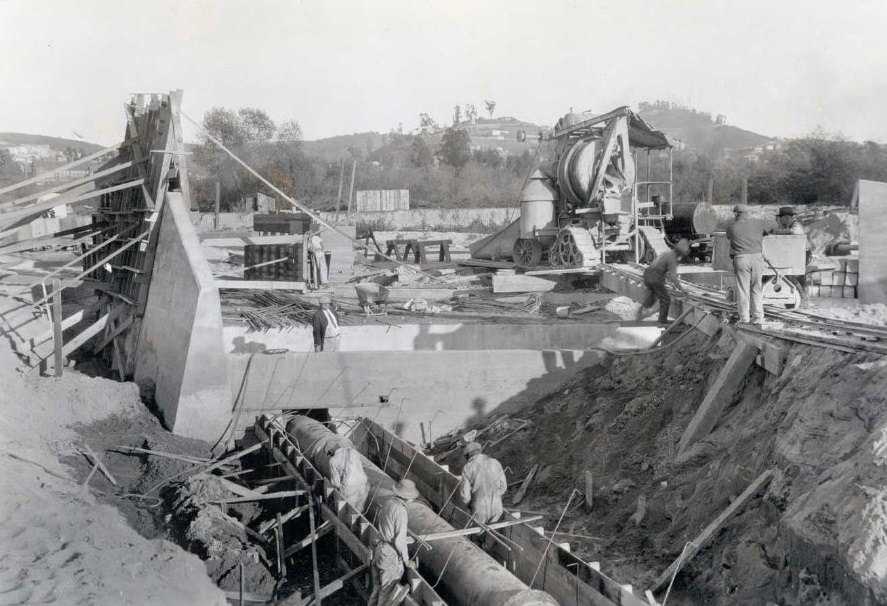
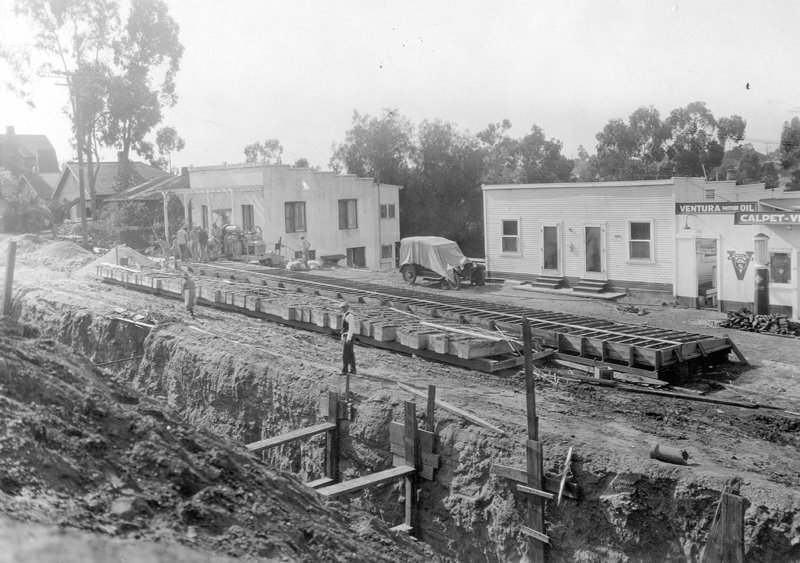
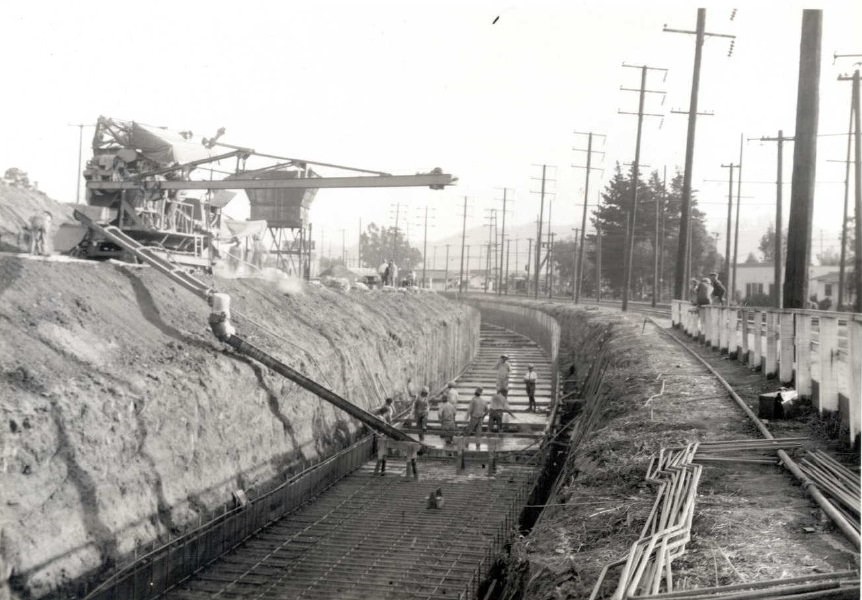
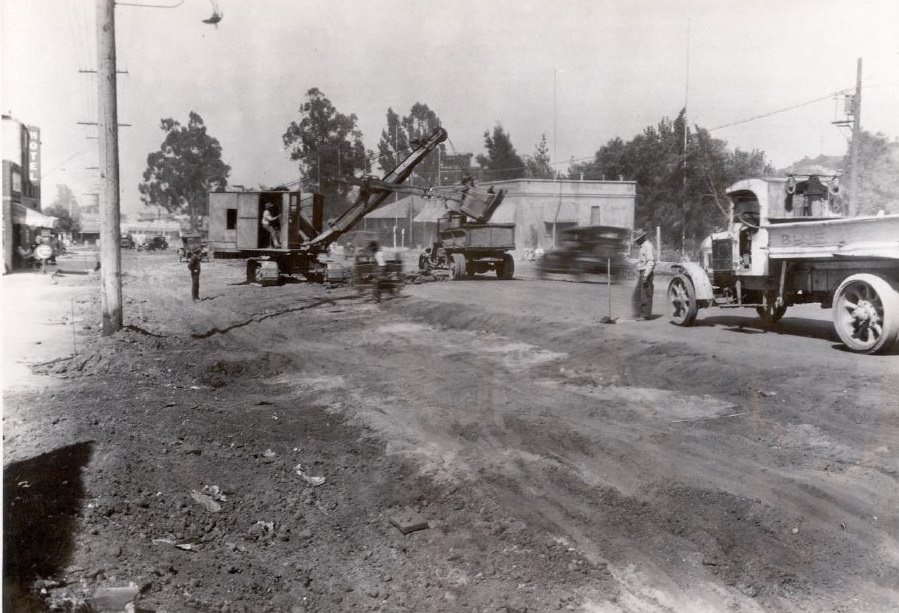
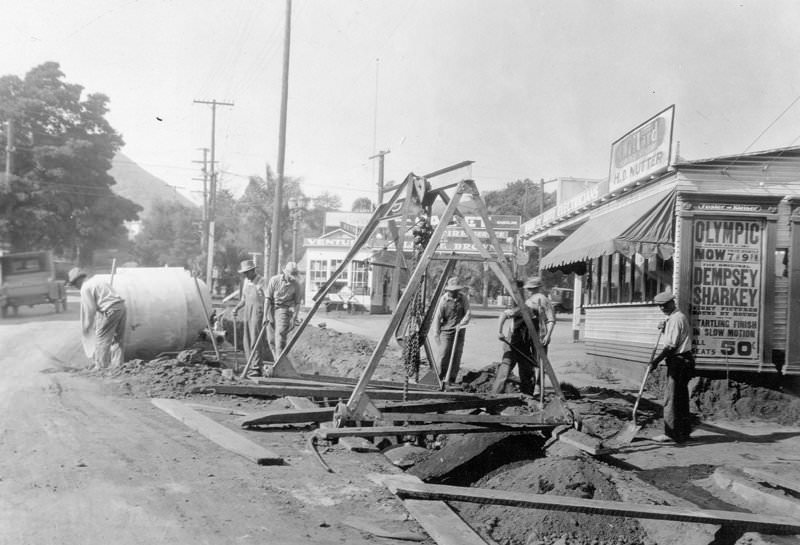
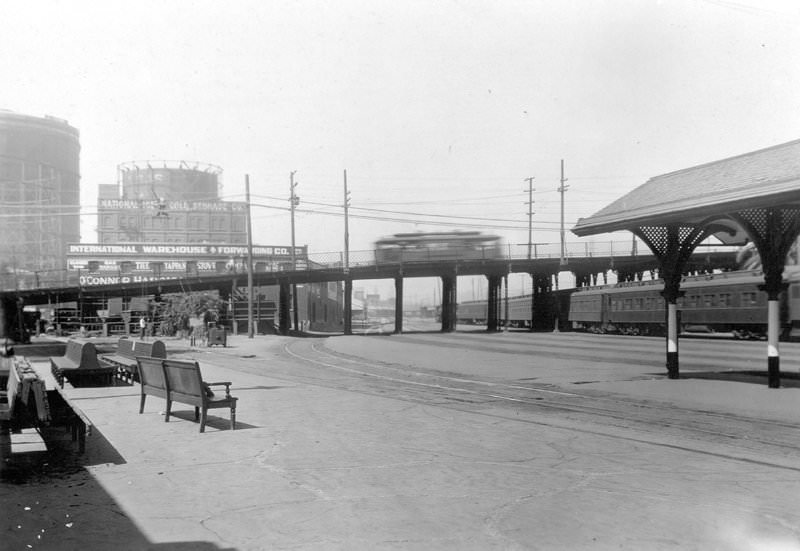
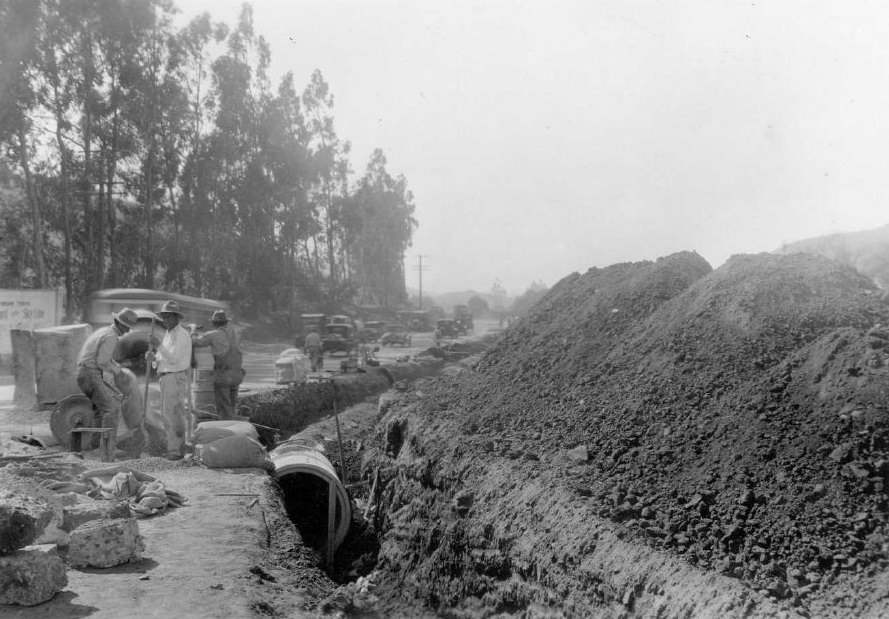
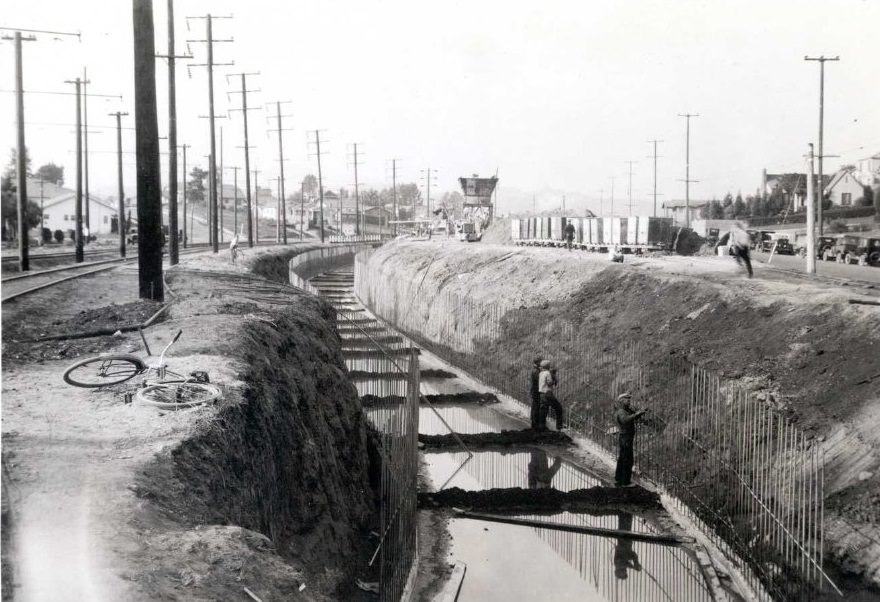
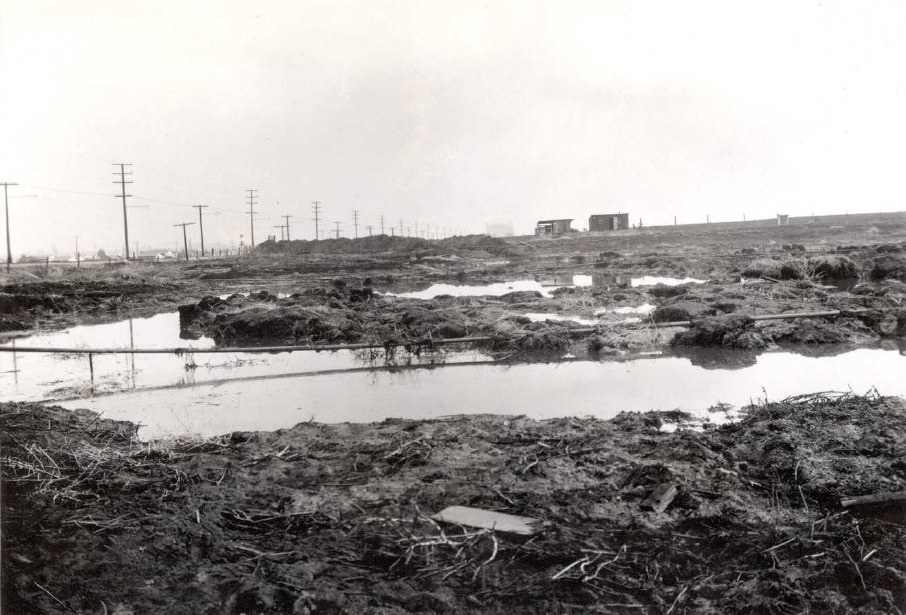
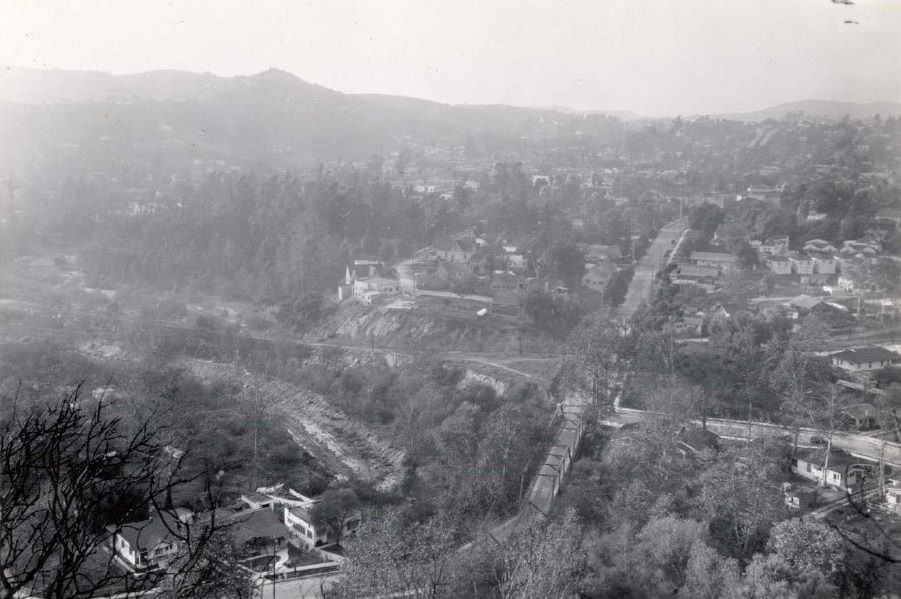
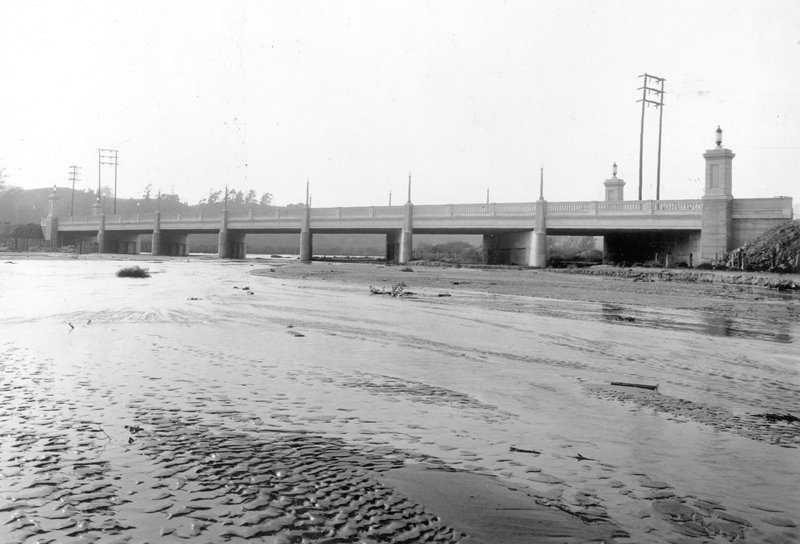
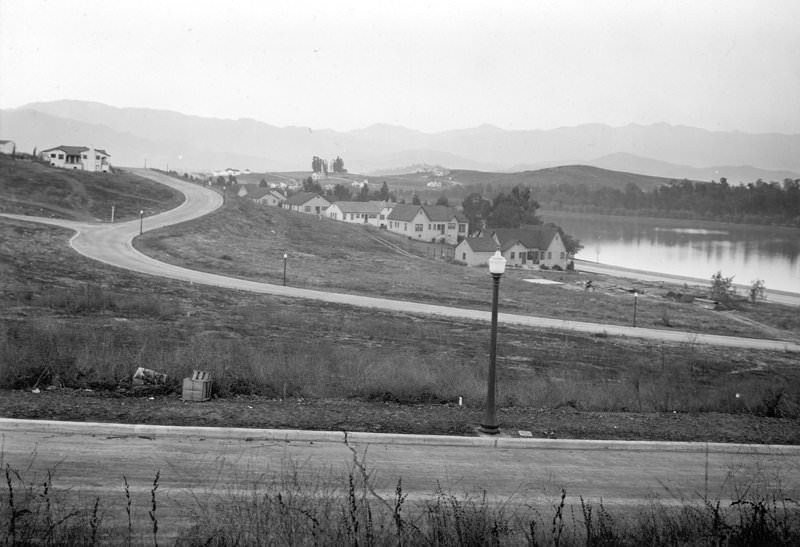
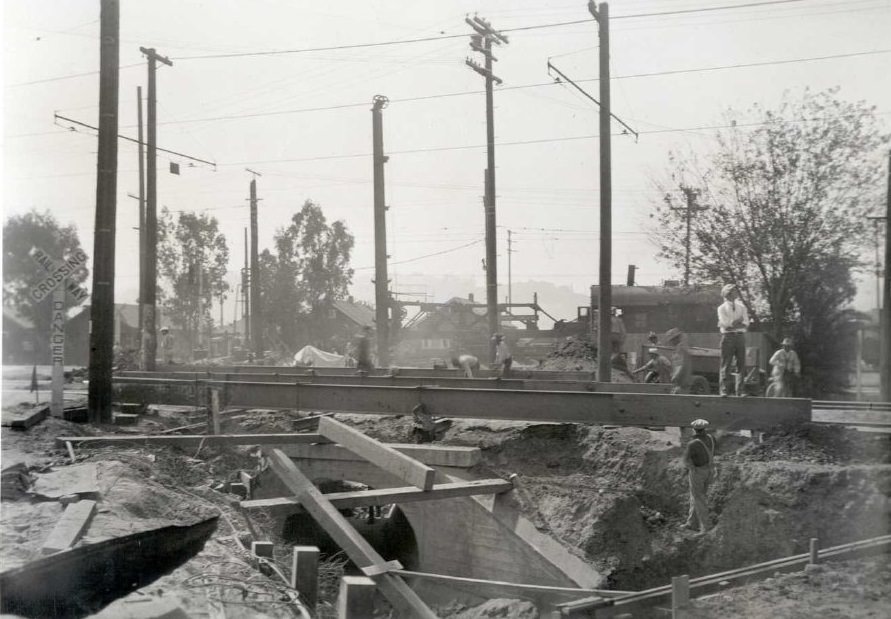

I love this stuff, thanks for sharing.